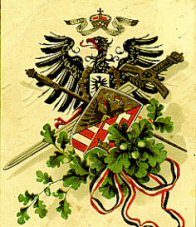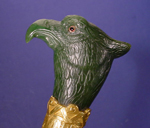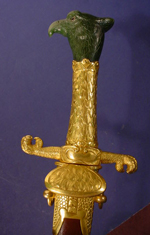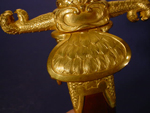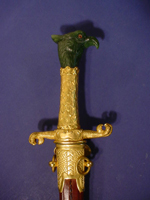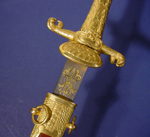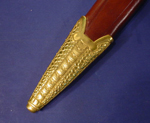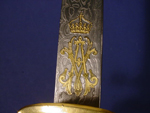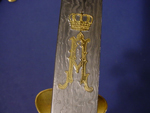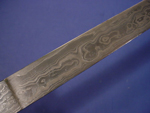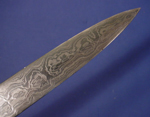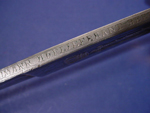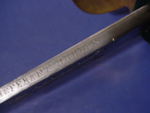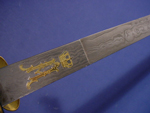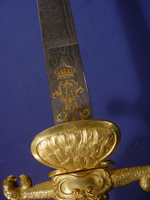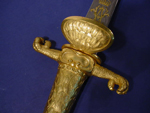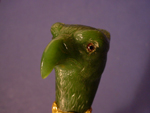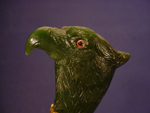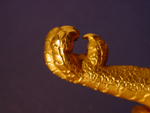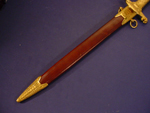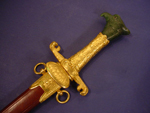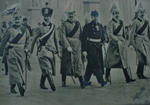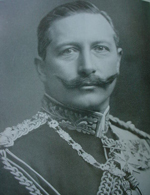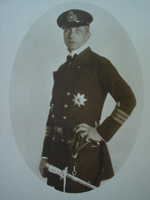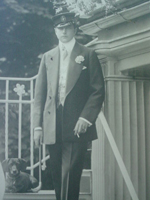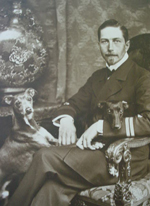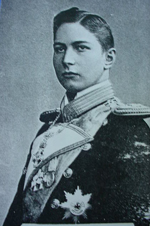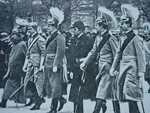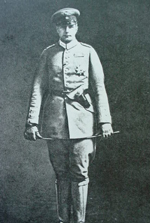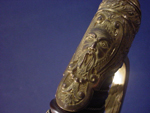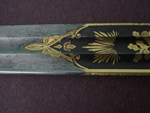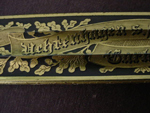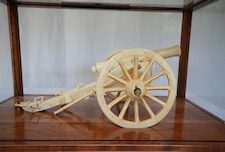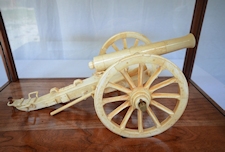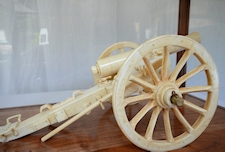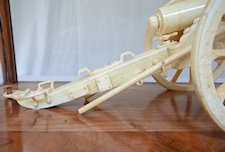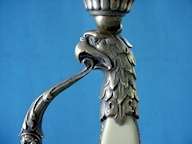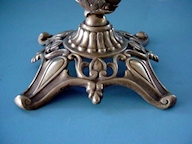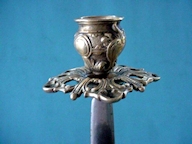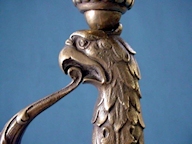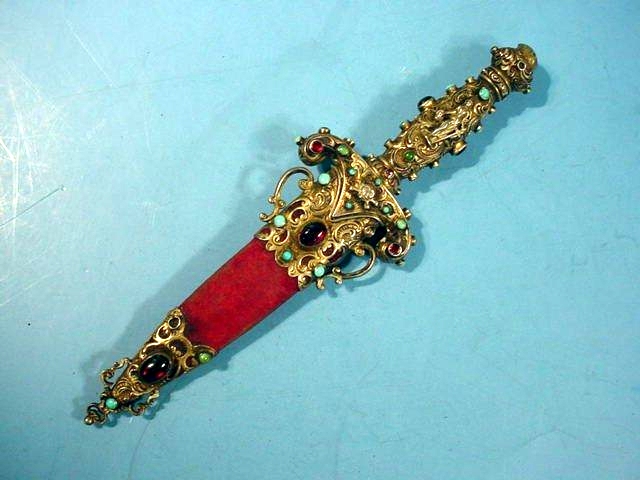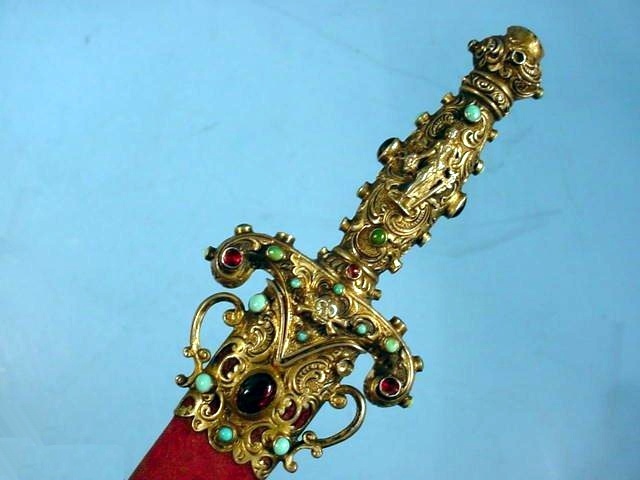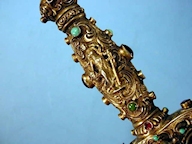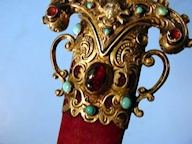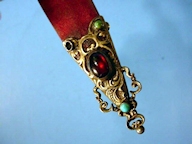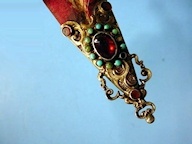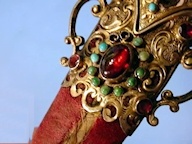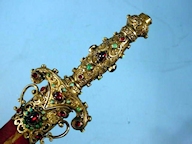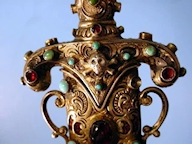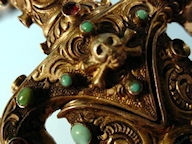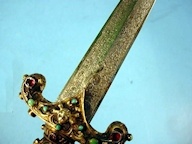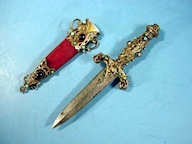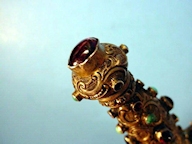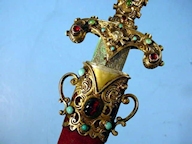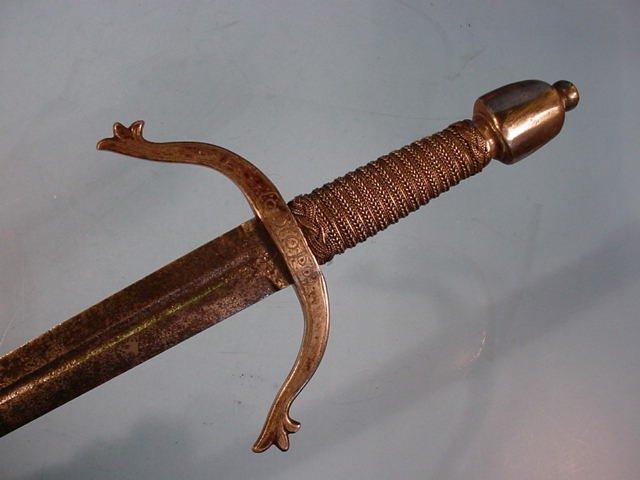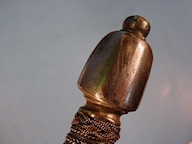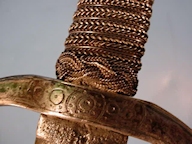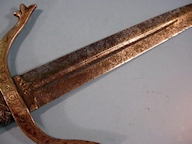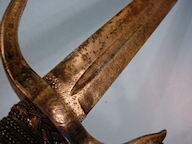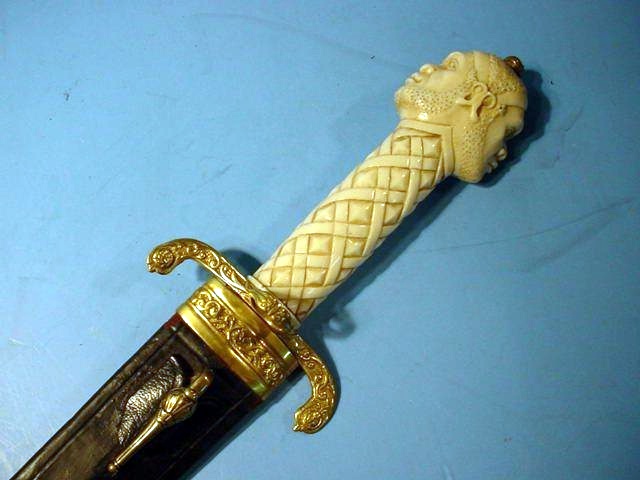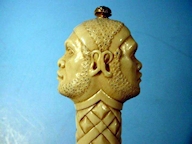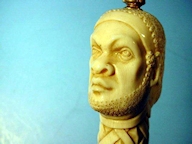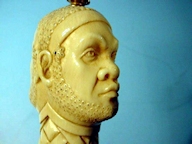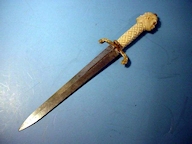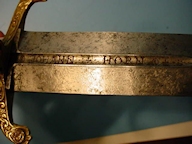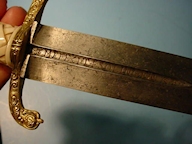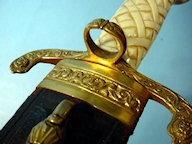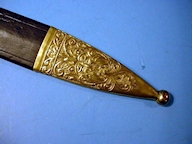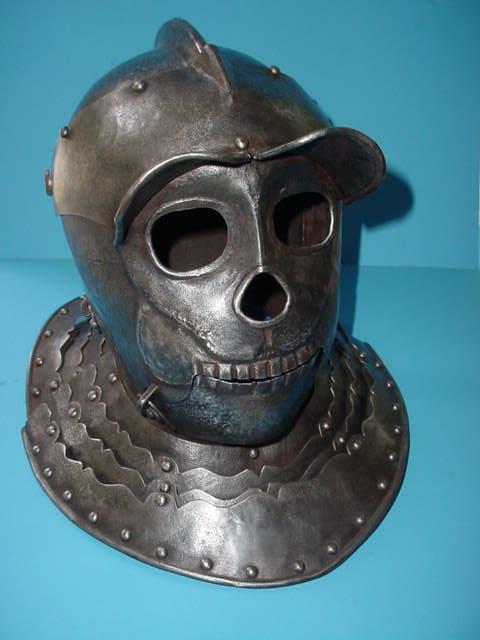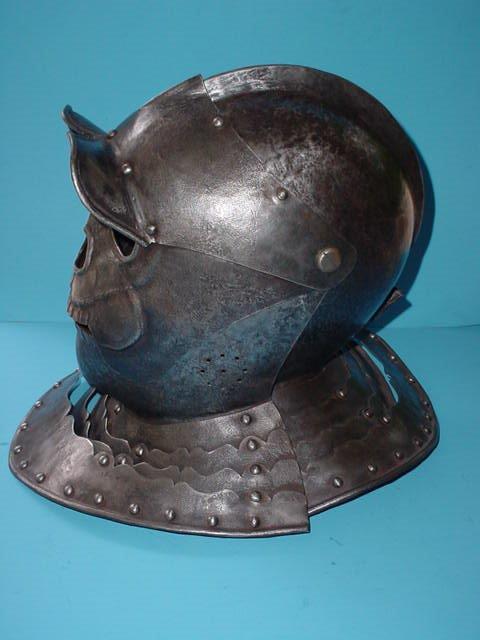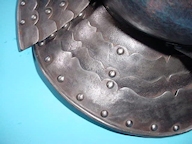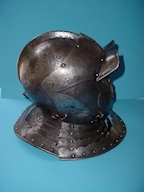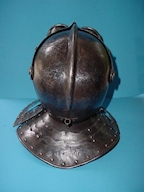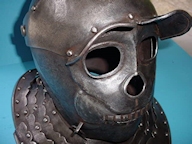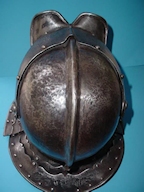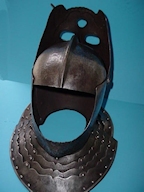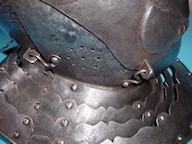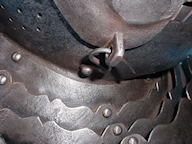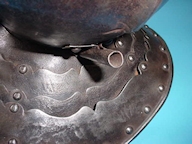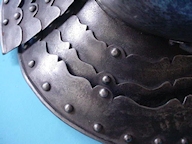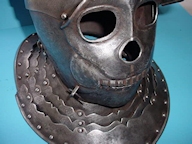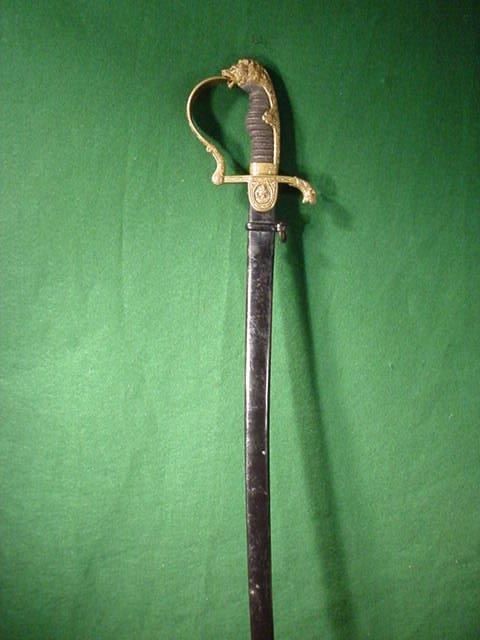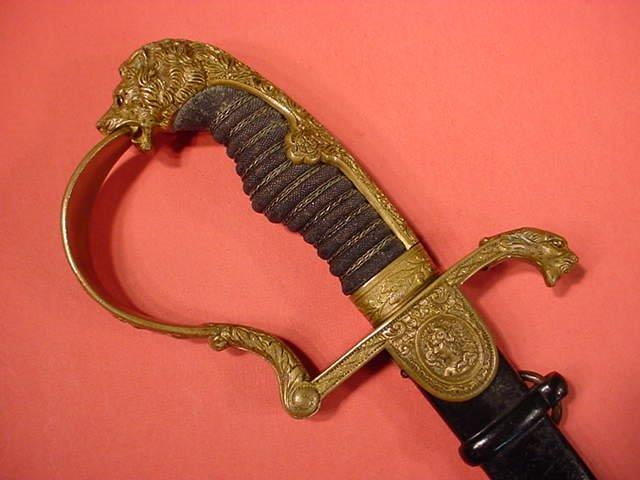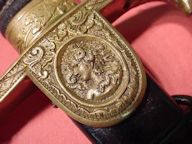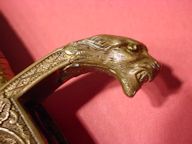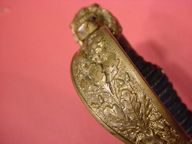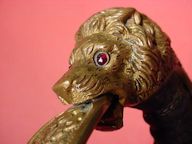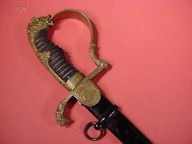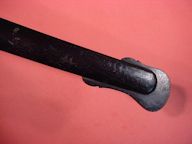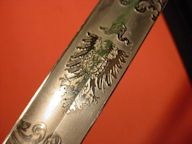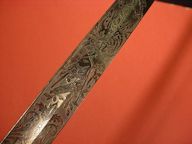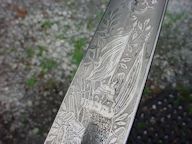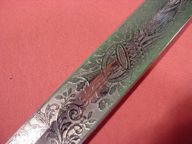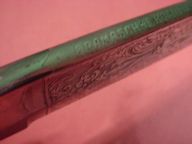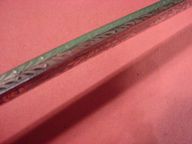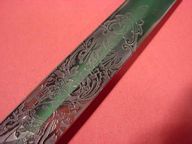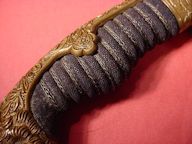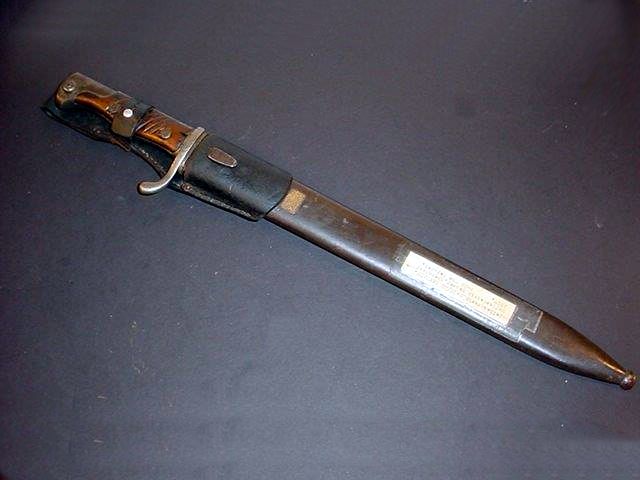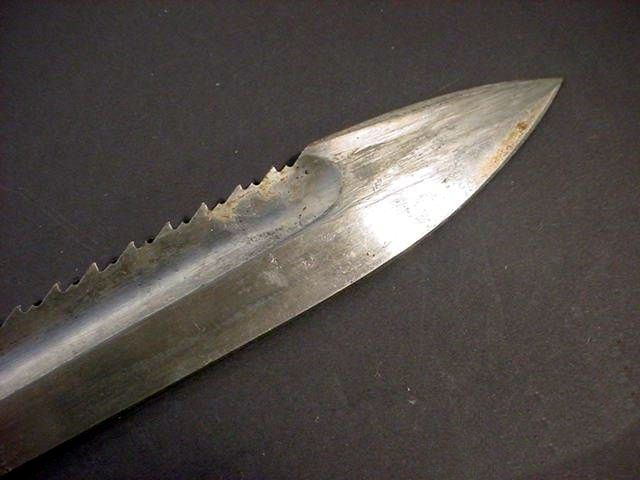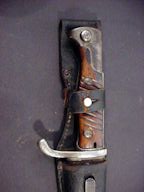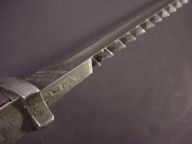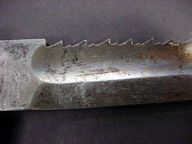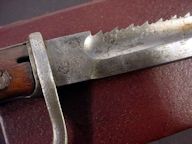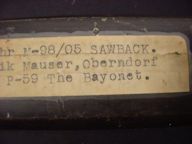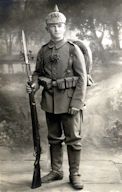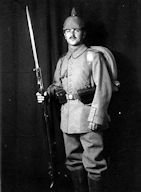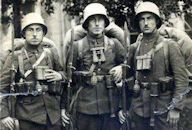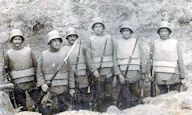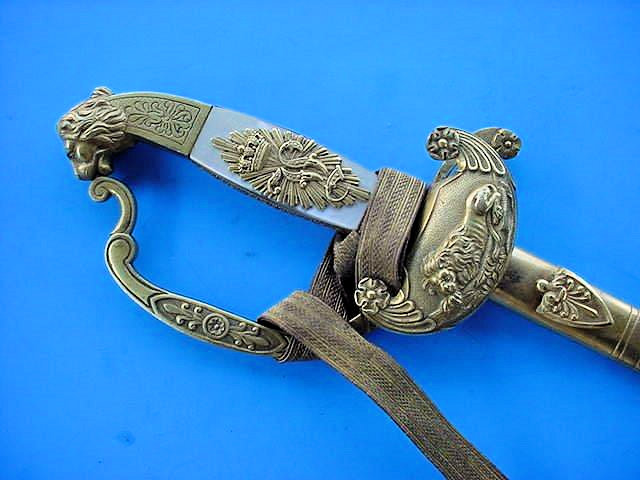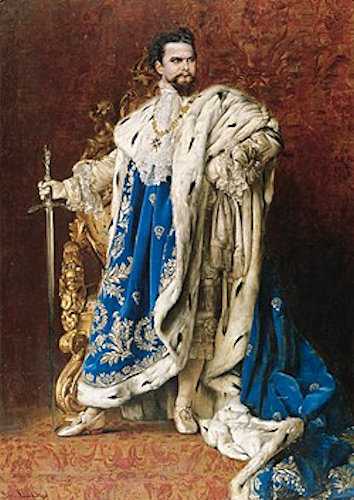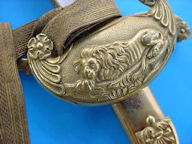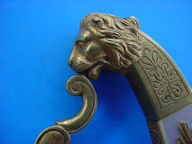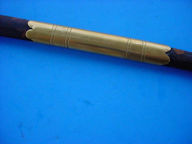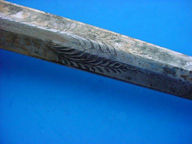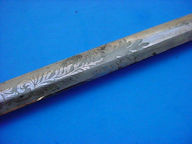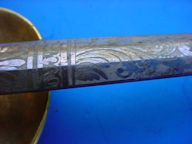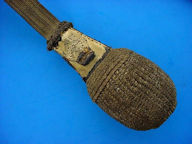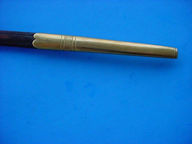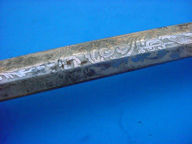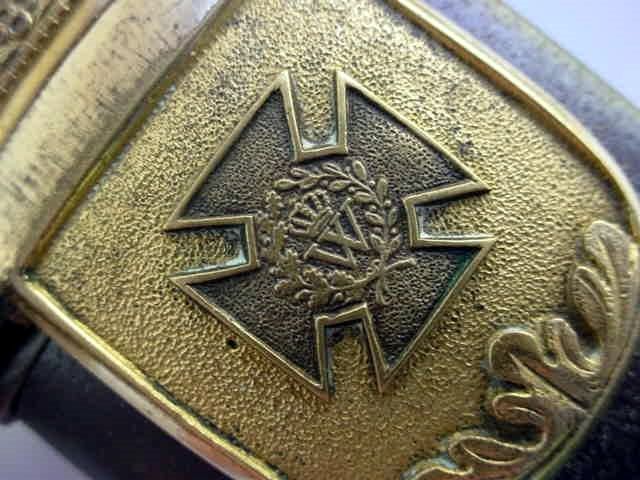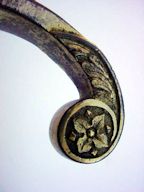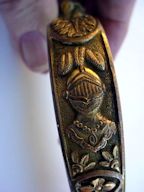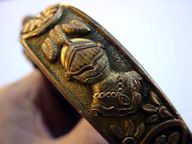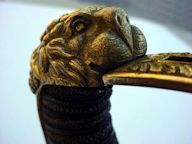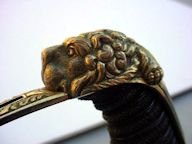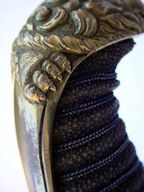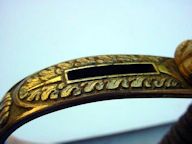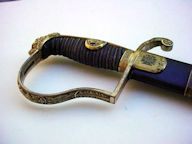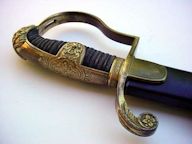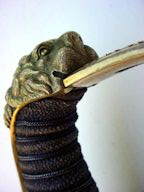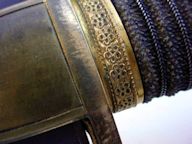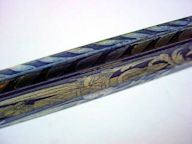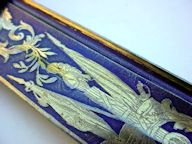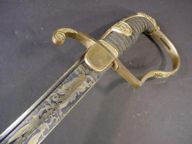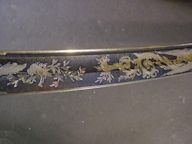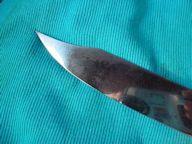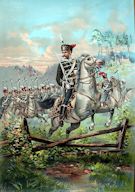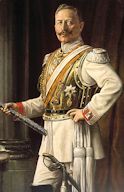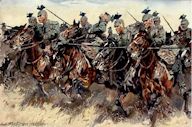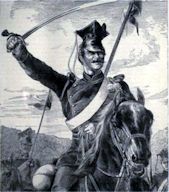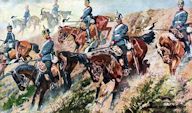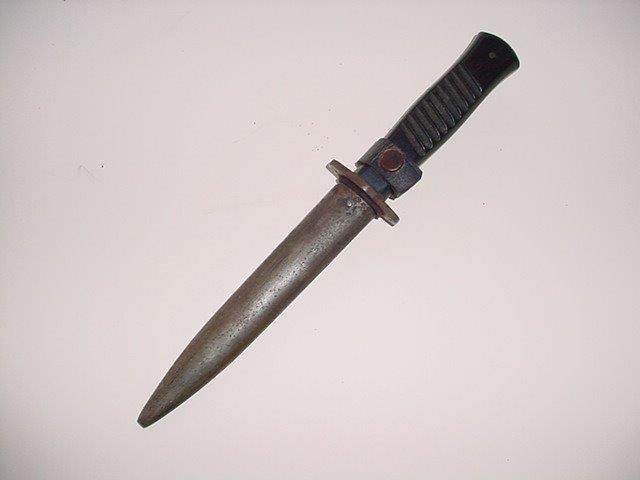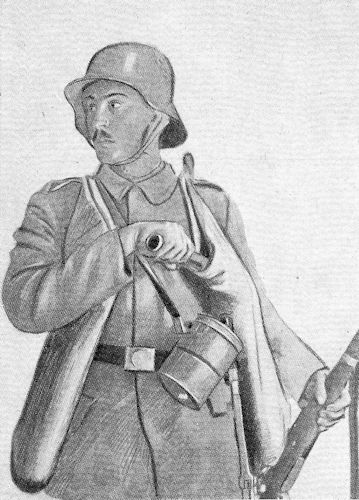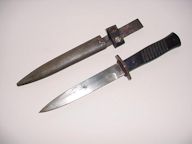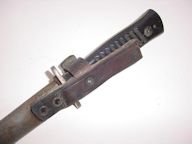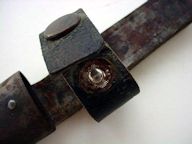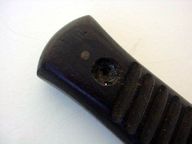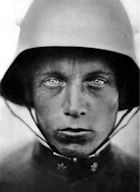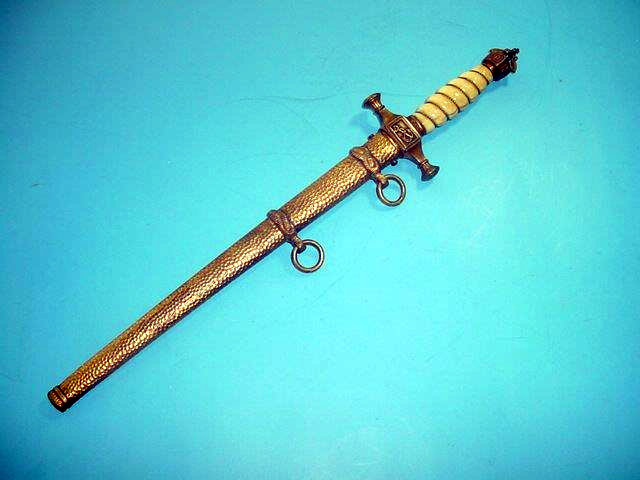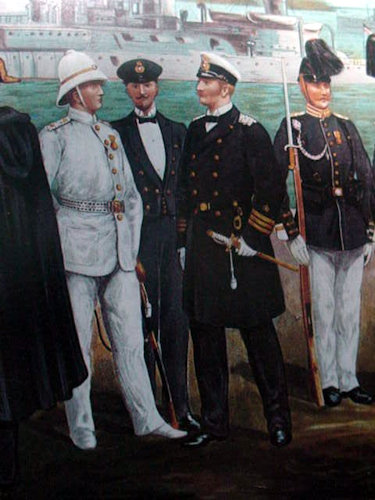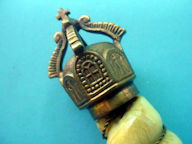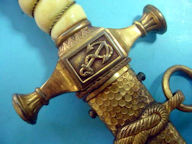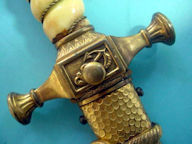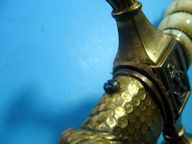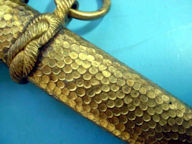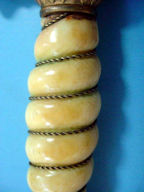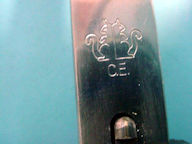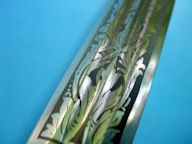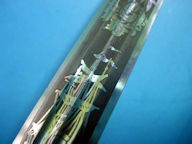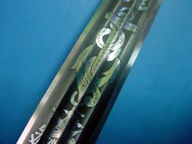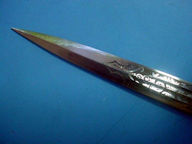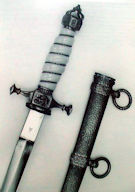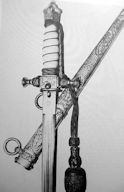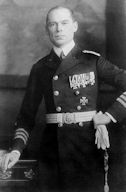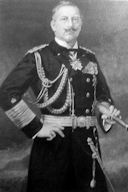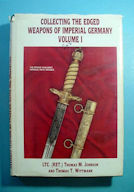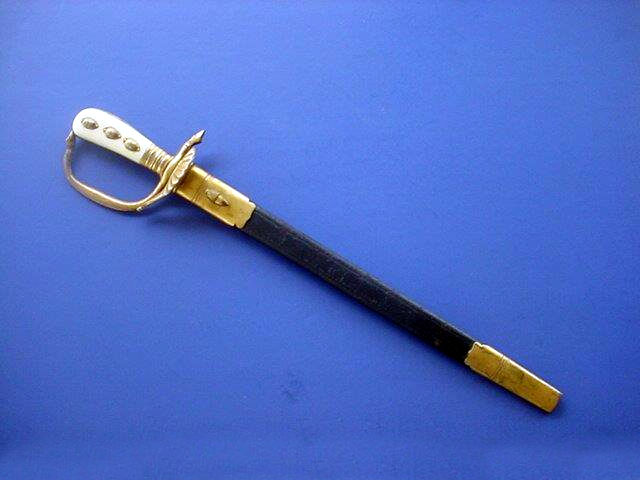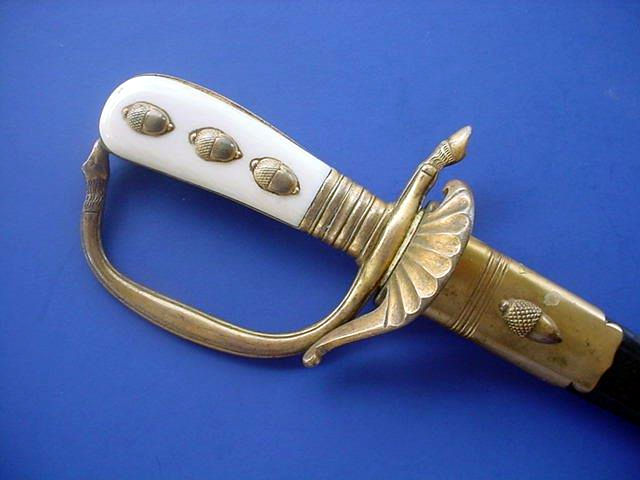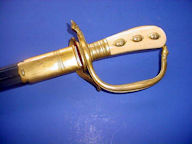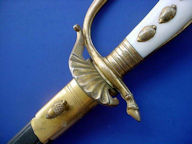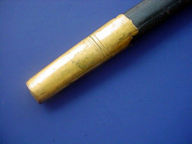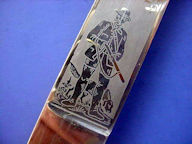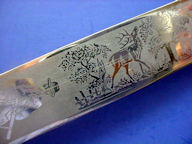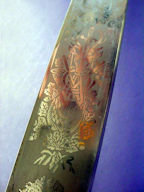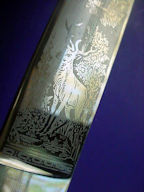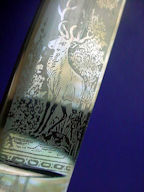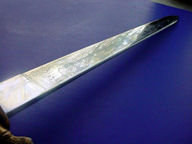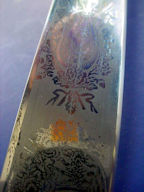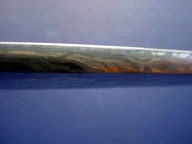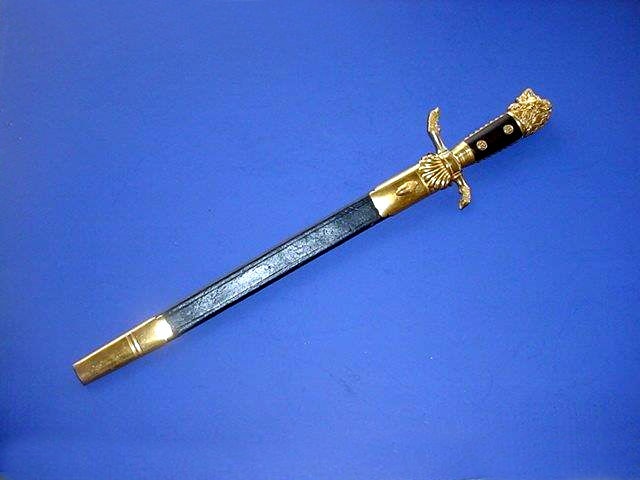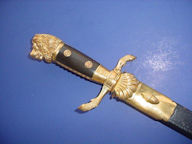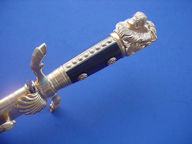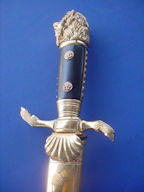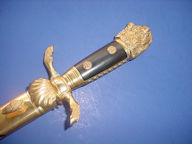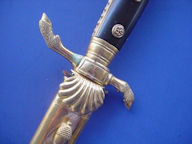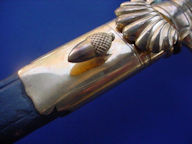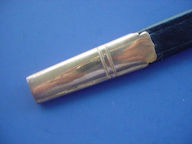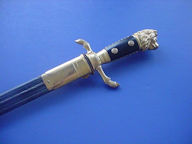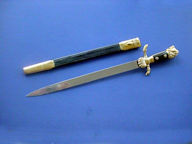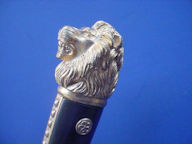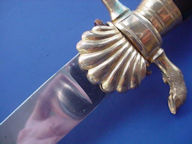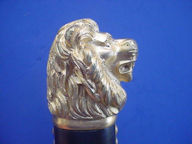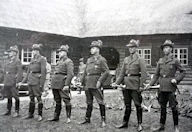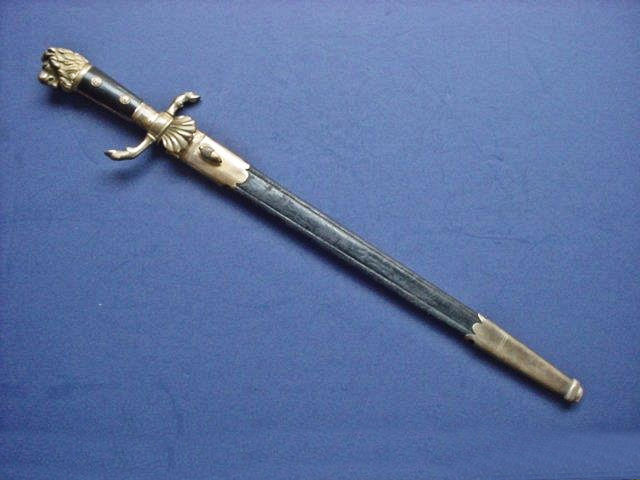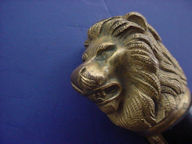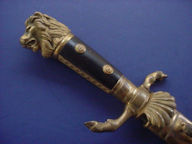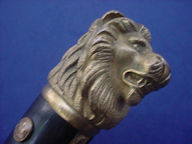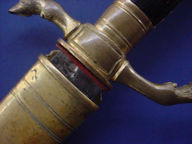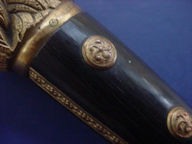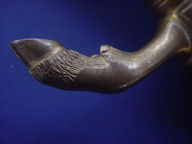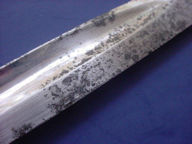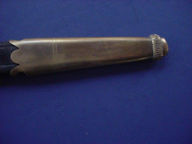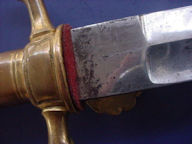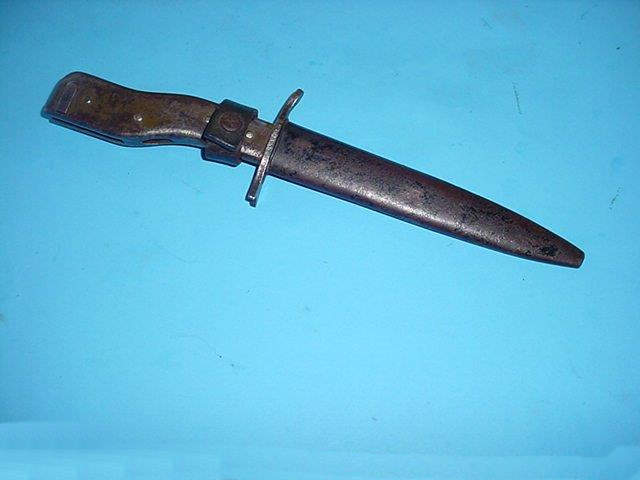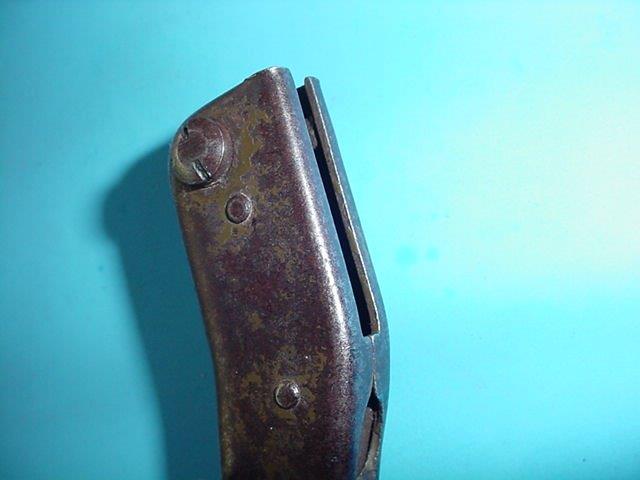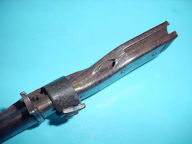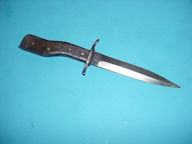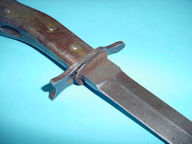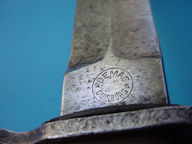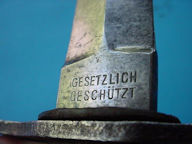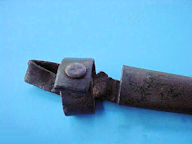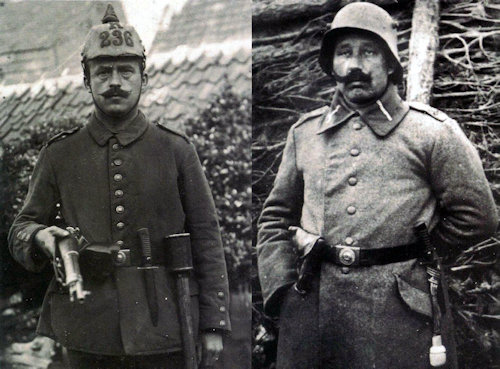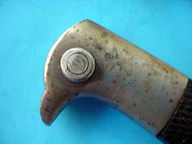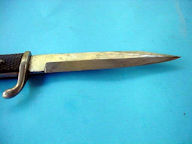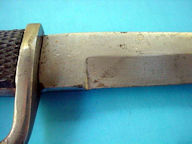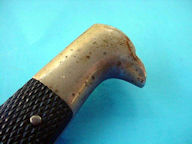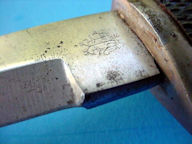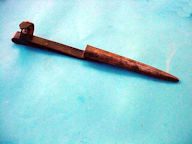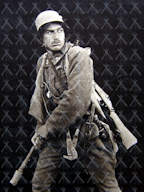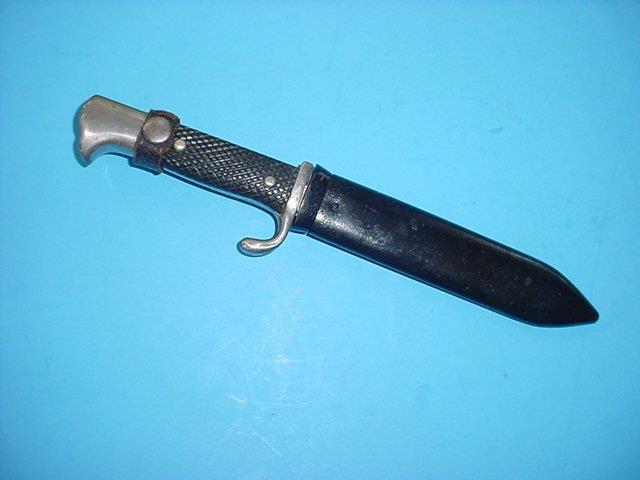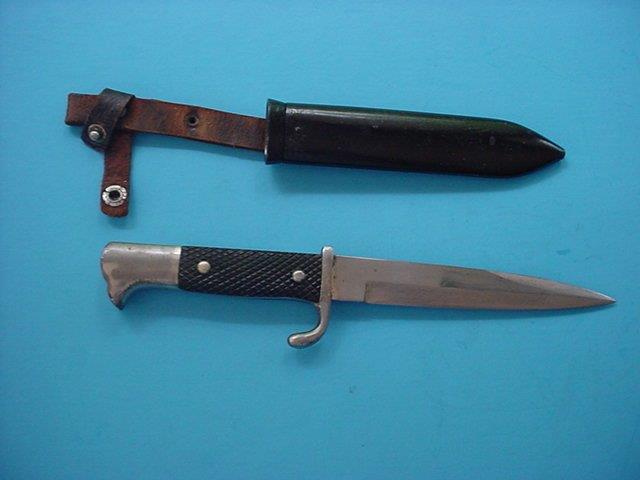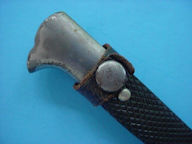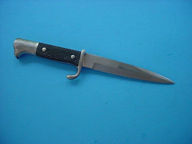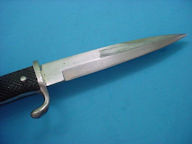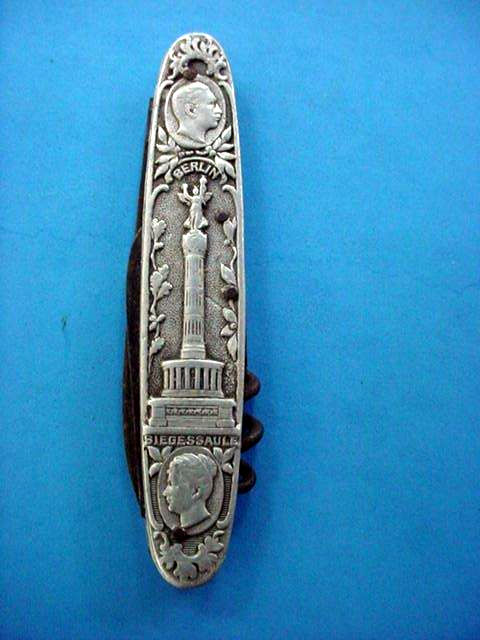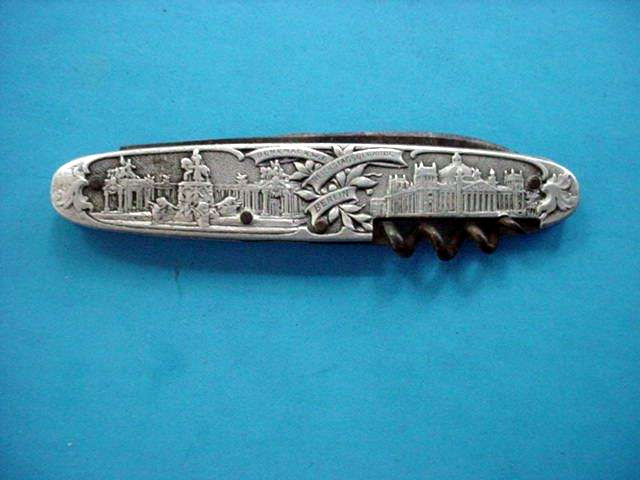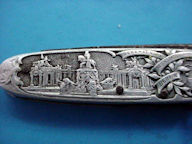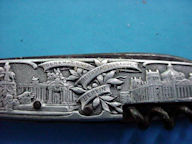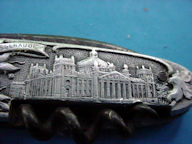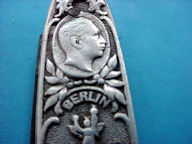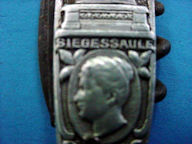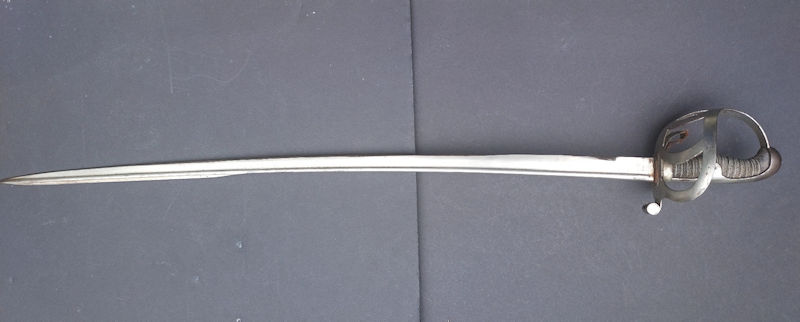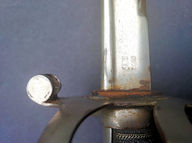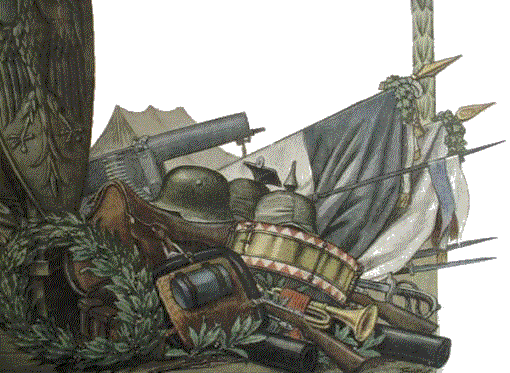|
|
|
|
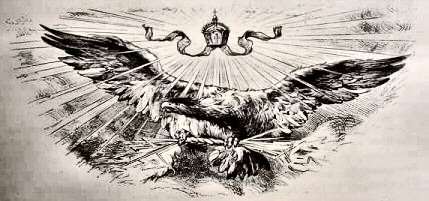

Page 5
|
|
|
Please be sure to visit our Kaiser Wilhelm II collection.
Also, take a look at our Frederick the Great gallery.
 |
 Prince Adalbert with his mother and the Princess |
Special Falconry Dagger Presented to Prince Adalbert of Prussia by His Mother The Prussian Kaiserin Auguste Victoria (Item KWEP 5-1; WILHELM 9-17; ANTWEP 3-7) |
DESCRIPTION: Here is the ultimate in royal gifts when it comes to weapons -- this is the actual falconry dagger that was presented to Prince Adalbert of Prussia 1884-1948 by his mother, the wife of Kaiser Wilhelm II (Empress Auguste Victoria) of Schleswig Holstein 1858-1921. She gave birth to seven children by Kaiser Wilhelm II, German Emperor and King of Prussia: Crown Prince Wilhelm 1882-1951, Prince Eitel Fredrich 1883-1942, Prince Adalbert 1884-1948, Prince August Wilhelm 1887-1949, Prince Oskar 1888-1958, Prince Joachim 1890-1920, and Princess Viktoria Luise 1892-1980. The Kaiserin dearly loved all of her children and she absolutely hero worshipped her husband, but the child she seemed to favor most was Prince Adalbert and she was often seen with him at Royal occasions and rallies prior to the war years and during WWI as well. They were often seen together at major events and even at minor fund raisers, etc. She was a good mother and wife and she was extremely conscientious in carrying out the public relations, plus charitable and welfare work that of course was an expected part of Royal duties. She had great interest in German cultural pursuits and a definite engrossment and actually a vivid affection for the arts. There was a genuine and widespread sense of loss and mourning amongst ordinary Germans when she died. Her funeral was marked with much spontaneous public grieving as well as the more formal solemn rituals of the Imperial Prussian state. Prince Adalbert, the third eldest son of Wilhelm and Auguste Victoria was born in the Hohenzollern Palace at Potsdam on 22 September 1884 and died in Switzerland 22 April 1948. He married Princess Adelheid (Adi) of Saxe Meninigen (1891-1971) on the 3rd of August 1914 in Wilhelmshaven, Germany. The young Prince had a passion for the tales and swashbuckling sagas of the sea and of course we know he was named after the earlier Prince Adalbert (1811-1873) who through the Hohenzollern Hierarchy was his distant relative. This Prince Heinrich Wilhelm Adalbert was the commander in chief of the Prussian Navy, as well as a great naval theorist and admiral of great renown in the turbulent 1840's and 50's. He was instrumental in the revolutions of 1848 and in founding the first unified German fleet, the Reichsflotte. During the 1850's he did much to form and establish the Prussian Navy as an independent naval power. The dream of our young Prince Adalbert, Ferdinand, Berenger Viktor, “Hohenzollern” was to become a naval officer in the tradition of his illustrious ancestor and he was ever cognizant of the fact that the Kaiser, his father was extremely obsessed with the sea and naval affairs. In 1889 at the inauguration of a new seaport in Stettin on September 1898, the Kaiser stated these prophetic words: "Unser Zukunft Liegt auf dem Wasser." (Our future lies on the water!”) And three years later Prince Adalbert officially joined the Kaiserliche Imperial Marine. It was the greatest day of his life and he entered as an officer having earned his rank in the naval reserve. On this auspicious occasion his father, the exceedingly proud Kaiser, presented him with a magnificent (one of a kind) cased and heavy naval dagger and ‘What a dagger’!!! Unlike any other dagger of the Imperial Navy, this one was entirely constructed in silver (800), not brass as would be usual and it had a genuine ivory grip. The blade was made by the WKC Company - “Weyersberg und Kirschbaum” who were so proud of it that they featured it in their turn of the century catalog as a prime example of their mastery of the art in the production of swords and daggers. The fittings and scabbard were by the famed Berlin jeweler to the royal palace, Sy & Wagner. In very highly raised letters the legend on the blade said “Meinem Lieben Sohn Adalbert Bei Seinem Entritt In Die Marine." Even the scabbard is a work of art. In the mid-section of the scabbard is the letter (A) and above it the typical crown of the Prussian prince. Originally Prince Adalbert was presented to the German admiralty on 24 June 1894 at the tender age of 10 years old. On this occasion the Kaiser said of his son “This moment when Prince Adalbert becomes one of you is of the most eminent importance to the entire history of the Fatherland!” One can only imagine the effect such a statement must have had on the formation of such a young mind. Thomas Wittmann in his book Collecting the Edged Weapons of Imperial Germany Volume One is to be credited with some of this information. Wittmann also said of the Prince that when Adalbert was an unmarried officer he traveled extensively throughout the world on German war ships as well as on the Royal Yacht “Hohenzollern.” It is said that the Prince was rather a rake with the ladies in his seafaring days, but please understand this activity was absolutely not approved nor condoned by the Kaiser or the royal house of Hohenzollern! Later when his earlier passions cooled, he married Princess Adelaide and he became a Korvetten Kapitan and was the Commander of His majesty’s ship, the Dresden, at war’s end in 1918. At one point in his naval career, he led a German Naval Marine landing party in heavy hand-to-hand combat action, thus he won the Iron Cross. This was worn by him at all times after it was ceremoniously awarded personally by his father along with an impressive scattering of Royal orders that he received from many of the countries allied with Germany. We counted 20 to include of course the Prussian Black Eagle, Red Eagle, House Order of Hohenzollern and Order of the Prussian Crown. Besides these he received the highest decorations of Italy, Netherlands, Austria-Hungary, Portugal, Romania, Imperial Russia, Turkey, Zanzibar, etc. He was a genuine hero and probably the noblest son of the German Hohenzollern Dynasty. The Prince’s Falconry dagger: We have said previously that the Empress favored Prince Adalbert as the dearest of all her children. Not to say that she didn’t love each and every one of them individually but Adalbert possessed the distinct possibility that his ecstatic love of the sea and his great fervent ambition to be a naval officer that was always first and foremost in his young mind, somewhat advanced him in the great favor of his mother. The Kaiser rather favored the Crown Prince Wilhelm, his namesake and heir to the throne, but he lavished attention all over his young sailor son as well. The Prince yearned to gain this nautical dream of his so adamantly that both mother and father thought him to be the most ambitious and dedicated of all their sons. His impassioned aspiration was most genuine and this young lad was admired by all in the Imperial court who knew him. Thus when the Kaiser gave him the fantastic naval dagger, the Empress was so impressed having seen the great joy it brought to the prince she immediately decided she would also present him a dagger that would have appeal to him as a royal Hohenzolleren prince! When Adalbert was still a child it was toy ships, toy sailors, that were his favorite playthings and he had his personal pond on the Imperial palace grounds where he could sail his tiny ships. But his greatest prizes later as an adult were these daggers presented by his loving parents to celebrate his reaching his ever present dream. Adalbert was a noble seaman and a true gentleman. However, his one vice seems to have been his consistent seeking of rather amorous adventures in his various travels even though these were before his marriage. Eventually there were more amorous conquests; unfortunately for him the word got back to Papa. We are all unfortunately subject to human frailties! *Authors note! His father we know was a very strict religious Lutheran adherent and a very strict authoritarian and he insisted that his sons “tow the mark”! Discipline and order were implemented in them from an early age and he expected that this rigid discipline would continue to be observed throughout their entire lives. Adalbert, however, was the only sailor in the family and maybe the lust of those who “go down to the sea in ships” was acquired in his many cruises to foreign lands. He was handsome, rich, regal, and important and the girls flocked to him like the mermaids of the deep flocked to Poseidon! Unfortunately, this led to his downfall not so different than if he had been shipwrecked by the beckoned call of the beautiful siren known as the Lorelei of the Rhine! Today we look at this as rather risqué but forgivable, after all it was just a young man sewing his oats! But at the Royal Hohenzollern palace in Berlin, this turned out to be a scandal of gigantic proportion! When news of his more infamous intimate escapades got back to the Kaiser even while the war was raging, the Emperor was livid and Prince Adalbert was banished from the Palace. He never saw his father again, and the only one contact (a sad one) was when he came to Haus Doorn in Holland where the Kaiser who was exiled there in 1918 died June 4, 1941. The Prince arrived there and we are told he did not speak to his brothers and sister but simply went to the bed that the Kaiser died upon (then empty) and placed a single red rose upon the pillow with a note that said: “Gott Segnen Meinen Vater Das Kaiser- Sein Sohn Adalbert.”(“God bless my father the Kaiser - His son Adalbert”). After this he turned and immediately left and did not visit the Bier of his father. Before this he actually sold his entire estate, his house, his other possessions, his medals, his naval uniform, and obviously this included the two beloved daggers and several swords. He then moved to Switzerland where he lived in seclusion for many years. The Prince died in the Swiss Canton of La Tour de Peilz on 22 September 1948. His wife, Adi, lived until 1971 and while she had always hoped a spirit of forgiveness would be forthcoming from the German Emperor during her husband’s lifetime but it was simply not to be. How the daggers finally came to the U.S. is still a mystery to us. The naval dagger has a fascinating post-war history to it but the fascinating story is just too lengthy for us to unravel here, but it involved the grandson of Prince Adalbert who unfortunately is not particularly a credit to the family name. It involves one of our chief historical advisors in an intriguing adventure 25 years ago who by the way was one of the last custodians of both daggers. It is a story of international intrigue, attempted fraud on the part of “sub-royalty” and rather high adventure that must be reveled someday. We have the highest respect and regard for the memory of Prince Adalbert and his Hohenzollern family but in my estimation he was not really the black sheep of the dynasty -- it was much later that a said to be royal personage entered the picture who still carries the family name (a fascinating story that will be tabled for now!). The Royal Falconry Dagger of Prince Adelbert: It should first be noted that the dagger has a pommel that has the carved head of a hunting falcon that is fashioned in genuine green jade. Now as we have noted that our Prince Adalbert was named after the great Prince Adalbert who was the Supreme Commander of the Prussian Navy in the 1850’s and the young son of the Kaiser attempted to emulate this eminent naval hero in every way he could. In 20 July 1853 the naval commander Prince Heinrich Adelbert worked diligently to bring about a superior German navy and he arranged for the hand-over of 340 hectares of Oldenburg territory at what is now Wilhelmshaven to the Kingdom of Prussia. This is in the eastern shore of the “Jade” estuary east of Bremerhaven; it was considered the best natural deep water port in the German North Sea coast and a good place for the naval base Prussia wished to build. The “jade bay” area offered deep water, a good base and anchorage and no ice in the winter. Oldenburg welcomed the idea of Prussia as a powerful ally. This was a major event that went far in securing practically the entire North Sea coast for German shipping and harbors for war ships. It was an event celebrated by the Prussian people as a major event in their history. We do not know how the estuary received this name but the spelling of jade is the same in English as it is in German and it refers to a metamorphic rock that is found mostly in the Orient and is considered a sacred stone in China. It is a gemstone of unique symbolic energy and also unique in the myths that surround it. With its beauty and wide ranging expressiveness, jade has held a special attraction for mankind for thousands of years. The other place where fine jade was found and revered was in the South American Amazon region with the Pre-Columbian people of the Mesoamerica regions and especially among the Mayan people , the “Ya’ax” chick or Jade meant life, fertility and power; it was considered greater and more valuable than gold. Could the fact that the royal mother chose to have the pommel decorated with jade have any connection with the first Prince Adalbert's accomplishments in securing this exceedingly important acquisition for Germany? Did the name of the Jade estuary influence her artistic and historical thinking and final decision in design? Always remember that “tradition” has been ever sacrosanct in the hearts of Imperial German rulers. Now, like his namesake, the young Price Adalbert was a world traveler vising many countries. One of the most noteworthy voyages made by the earlier Prince Adalbert was his expedition up the Amazon River and the Xingu in 1849. It is said that when he returned from this intriguing journey he brought many souvenirs and important relics home with him to include some examples of Brazilian jade carved by the ancient Mayas. Also, he brought some perfect examples of uncut jade. It does not take much speculation or extrapolation to figure out who might have acquired some of these treasures. His most ardent admirer, the young son of the Kaiser, Prince Adelbert was elated to finally receive these gifts that had belonged to his illustrious relative. It is also not difficult to imagine that the Prince bequeathed a spectacular piece of this jade down through the family and that it very well could have eventually became the property of Kaiser Wilhelm II and the Empress Auguste Victoria who no doubt turned it over to an extremely talented carver who fashioned the Falcon's head to be the crowning finial to the fantastic dagger. Yes, this theory is extrapolation from several sources but we believe it is logical for we know that in our cumulative historical knowledge amassed over periods of many long years in pursuit of such items and learning about them we can say that we know of absolutely no instance other than this one where jade was utilized in the construction of a German edged weapon. This piece is unambiguously and consummately unique and unprecedented in the history of edged weaponry. It emblematizes Royalty like no other edged weapon that we have ever heard of. It actually seems to emit power, majesty, Imperial dynamism and seeming omnipotence. To hold it in one’s hand brings about in the mind of true Germanophiles an extrasensory perception, a distinct feeling and sensation born of passion for the aesthetically beautiful and the profoundly important. But what would George Bush or Al Frankin get out of holding it? (Answer- Nothing!) The dagger with the Falcon's head pommel has glass eyes and a very pronounced beak and has gorgeous carved feathering throughout. The gilt bronze feathered grip works down to the cross guard that has the claws open to clutch the prey! The very pronounced clam shell also has fine simulated feathering. The blade measures 13-1/16" in length with the monogram set in gold that depicts the Crown of the Kaiserin and that is centered over the cyphers (AV) Auguste Victoria and on the reverse side is the (A) for Adalbert under a typical Prussian Princes crown also set in gold lettering. The spine is marked M. Neumann Hoflieferant-Berlin. The word Hoflieferant means that Herr Neumann was a maker to the royal palace or Hof. The scabbard is in high quality brown leather with a gold bronze two ring throat with an engraved mosaic like pattern and matching boot (or tip). The entire dagger is in excellent plus condition including the fabulous Damascus blade that is an example of the ultimate in German Damascus mastery. The dagger was certainly a regal gift by an adoring Mother but what of its general usage? Falconry was practiced and enjoyed by the European nobility for centuries but especially and notably in Germany. We know that Prince Adalbert was an aficionado extraordinaire in this the sport of kings. When he was not sailing he was the ultimate falconer! The dagger certainly does take on the outward appearance of a medieval falconer’s weapon as seen in museums in Europe. This without a doubt would have been the ultimate gift to this young practitioner of falconry. Certainly the dagger had no actual utilitarian use but was proudly worn as a resplendent part of the outfit that was donned when the Prussian Prince would be indulging in this his favorite pastime. So in closing this narrative, the longest description we have ever given on any dagger or sword, we can only say we are practically euphoric to be privileged to handle this awesome and priceless relic of the history of the age of great opulence, refinement, pomp, glory and high adventure! However we now have to sadly say that the days of the proud and glorious Hohenzollern regime are now past tense never to return! If any priceless relic would unequivocally summon up memories of that eloquent era of Teutonic Imperial glory and splendor it would have to be this dagger since we don’t have the Royal Prussian Hohenzollern crown to offer. When I view this magnificent relic, I am reminded of the wonderful book by author Margaret Mitchell about the fall of the noble Antebellum South and the subsequent film that evolved. The quote was: “Look for it only in books for it is no more than a dream remembered. A civilization GONE WITH THE WIND”! PRICE: SOLD |
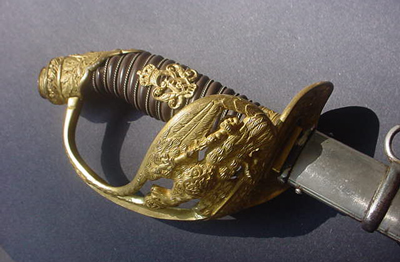 |
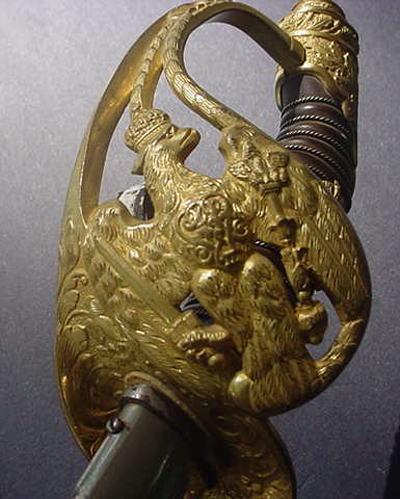 |
Spectacular Grosse Degen Model 1889 by WKC (Item KWEP 5-2; ANTWEP 2-37) |
DESCRIPTION: Here is the finest model 89 sword we have ever encountered; it is in a word “spectacular”. Absolutely the finest workmanship by the company that produced the state of the art swords for the Kaiser and Reich, Weyersberg-Kirshbaum and Co. (WKC). The history of this Solingen company goes back into the middle ages and its trademark ‘the king’s head’ was noted in 1560 but the heyday of sword making in earnest dates back to 1774 when Weyersburg first registered the ‘king's head ‘ as their trademark. This was the company that made the famed sword for Kaiser Wilhelm II and presented it to him in 1899. To see a miniature of this sword by WKC go to our Kaiserreich section (Item KWEP 4-8 & WILHELM 9-11). You can also read about the special presentation there also. Nothing in Imperial edged weapons in the Kaisers Reich can compare with the quality of WKC swords and we present here one of the best of them. This is possibly the finest one we have ever offered in a Grosse Degen Mod 95 and probably the best any one has offered at any time that we can recall. It is better than any of the 89’s that appeared in Tomas Wittman’s Horn Book on Imperial Swords and Daggers that was published under the title Collecting the Edged Weapons of Imperial Germany Volume 1 and there are some wonderful pieces from famous collections shown there, but none quite come up to the sheer beauty and exquisite construction of this particular gorgeous sword. Beautiful and gorgeous may be far too conservative a description to the advanced collector of German swords. This one truly is the “Holy Grail” of the Grosse Degen. These model 1889 swords were generally based on French or Prussian cuirassier broadswords but with a distinct pierced semi-basket brass guard that is closed rather than open like our presentation grade Prussian cuirassier sabre found at Kaiser Reich weapons (KWEP 4-1); this was the official infantry officer degen 1.0.D 89. The gilded bent hilt sets it apart from all the other patterns of German swords of the era. This one sports the greatest looking hilt imaginable -- graceful, flowing and the gilding is of the brightest richest, metallic look ever. The Prussian eagle is beautifully refined and of the greatest detail imaginable and the sword is so fine that the eagle is even detailed (inside) the basket as well as outside. The Royal Wilhelm cypher in the center of the grip is also oversized, far bigger than in the regular 1839 models. The pommel bears the likeness of the Nordic God Wotan and this is a clever addition because as king of the Gods of Aryandom he is a king in every sense of the word, and thus related I suppose to the King logo of WKC. At the top of the pommel cap is an oblong crown with what seems to be the letters G & k or G&R depending on how one holds it for inspection (right side up or right side down). The grip seems to be made from some type of natural horn (possibly Rhino) from the German colonies in German East Africa. Even this sets this sword apart because I have never encountered this type of grip in any German sword (ever!). This had to be a special custom order and very probably genuinely unique. The entire massive grip and basket hilt are probably completely unique. The Blade: We have so far described for you to the best of our ability the absolutely unique Grosse Degen. Other than the sword of Bismarck and the personal sword of Kaiser Wilhelm II, this is without a doubt a weapon that would be shown in the near vicinity of those illustrious swords if it were in the Klingen Museum in Solingen. Now it is time to describe one of the most beautiful and awesome blades we have ever seen on a mod. 1889 Preussisch Infanterie Offizierdegen. Let’s start with the markers name and logo found at the base of the blade where the blade meets the guard, usually the letters WKC and the king’s head are shown but obviously since this was a very special sword custom ordered and produced you will see both the king’s head and the knight’s head. This symbolizing the amalgamation of Weyersburg and Kirshbaum in 1883. They were the two most famous sword making companies in Solingen Germany. On the back strap or top edge is the name of the retailer who ordered the sword from WKC at the purchasers specifications. This was the firm of Gustave Gunther in the city of Metz. All the wonderful gilding is still intact and bright on the blade and where it is seen with a black-blue background. It is prodigiously stunning to say the least! On the front side is the legend that looks like Wehtenhagen S/L (Seinen Leben) Garke Metz 1895/96 so we know that the sword was presented in the same town that it was ordered in and this was ‘Metz’. The lettering is so pronounced in the blade that it could be read in Braille. All around the scrolls containing the letters are branch’s of Eichenlaub “oak leaves”. On the reverse side in a scroll is the saying in German ‘Den Feinden Wehr Schutz Meine Ehr!’ In German this can translate to either made to defend me from my enemies and to protect my honor, or, it can mean ‘defend and protect me from my enemies’! The sword was for a big man; it is fully 3 foot 4 inches long in its scabbard. The blade is made with maiden hair pattern damascus. Genuine Damascus! Not etched Damascus. It has a triple blood fuller-deeply grooved. Excuse me for the continual usage of the word beautiful but again, this word is almost insufficient to use when describing this awesome looking blade. If I am somewhat repetitive in my description it is only because I am fully under the charming spell of this magnificent sword. Last but certainly not least there is a monogram that it is not actually a royal cypher. It is for a Kaiserlich regt. of guards and it well might be the Forth Royal Grenadier Regt. Number (4). We can use some help on this one. The numeral 4 is topped with a classic intertwined set of initials surmounted with the Prussian crown. So what can we say except to use all those praise worthy descriptive words again. So that we are not so repetitive we will use a word that seems to cover all bases and we will declare this unique weapon ‘pulchritudinous’. Certainly there is not another available anywhere that could be deserving of this description. PRICE: $15,000.00 (and we hope no one buys it -- we love it that much!) |
 |
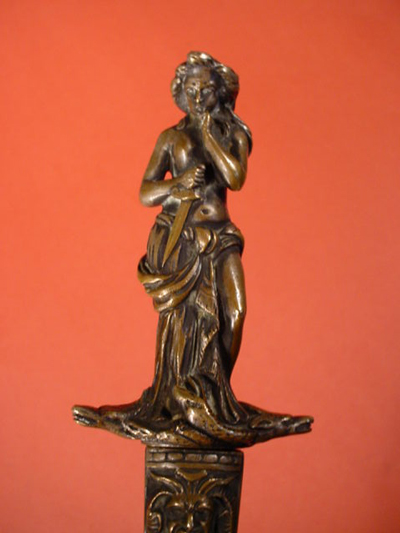 |
Bizarre Demonology Dagger “TeufelDolch” (Item KWEP 5-3 & SA 14-14) |
DESCRIPTION: Here is a real oddity. This was a knife probably used in demonic rites. In 1933 after Hitler came to power there was a general clean up by the SA Sturmabteilung (storm troopers) of certain buildings and residences where Communist and Masonic meetings and ceremonies were held. Among the anti-Nazi movements were some agitators, who besides being far to the political left, they were also to the left of all human dignity and order. The Dachau concentration camp in 1933 and 1934 not only had guests who were Reds, Masons, religious fanatics, destructive cultists, and other radical groups that had more or less declared war on the NSDAP. Seventh Day Adventists and especially Jehovah Witnesses were considered enemies of the Reich but also there were practicing occult devil worshippers (Satanists). When located and identified as such, these criminals were not so gently handled by the brown shirt troopers when their covens were raided. The knife we offer here was taken from just such a hovel in Berlin by an SA officer whose widow we bought it from years ago (1979). The lady was attending an antique show near Berlins Teirgarten (zoo). She attempted to sell it to an antique dealer who did not want any part of it but summoned our picker who managed to buy it from the elderly lady. She said her husband was always proud of his service in the SA and didn’t give a damn who knew it! He always told her to keep it next to his SA dagger with its engraved message “Alles fur Deutschalnd”! (All for Germany!). He said it should remind him and his son and daughter about the difference in the agendas of the men who would possess each of the displayed knives. One knife reflected values of loyalty and bravery while the other represented the powers of darkness and evil personified. The son went off to war in 1940 and never returned and the daughter unfortunately became an integral part of the American induced Coca-Cola “Kultur”. So, the good lady decided that the two daggers should go to a collector somewhere. The SA dagger was sold earlier and we ended up with this iniquitous but vastly interesting weapon from the dark reaches of mystery and wicked application. The dagger measures 9 inches long in its scabbard. The blade is quite lethal looking and is 4 ½ inches long and has a triangular shape better to pierce flesh with while causing much bleeding when withdrawn. The material, except for the blade, is bronze. The grip is fashioned with frightening accuracy and depicts in high relief an acolyte of Satan himself who holds a dagger similar to this one and seems to ponder who will be his next victim. At his feet are serpents while at his heels a gargoyles head seems to emerge. On the scabbard there is a face of a demon straight out of Hell, while a dragon type apparition seems to pay homage to this monster. Various vines that represent roots (roots of all evil) cling to the bottommost portion of the scabbard that has one more satanic face at the very tip. It is hoped that the original owner of this very abhorrent yet fascinating weapon didn’t have a very comfortable berth at Dachau and hopefully eventually was resolutely shown the error of his way and perhaps he eventually renounced Satan and all his ways and enlisted upon his release in the SA as was often the case. So, we offer this rare, unique dagger today in the hopes that it will be a valued collectable but with a message brought about forthwith. PRICE: SOLD |
|
|
Model Cannon Crafted in Bone (Item KWEP 5-4, KCARVING 1-8)
PRICE: $2,850.00
Germania International will not ship any item that contains any animal parts to any country where such items are prohibited!
 |
 |
Fantastic Find -- A Royal German Hunting Sword of the Early 18th Century (Item KWEP 5-5; HUNT 8-5) |
DESCRIPTION: Here is one of the most exquisite Hirshfangers we have ever seen whether in museums or private collections. Nothing in the Jadgd-museum in Munich would be better or more historically important than this piece. Absolutely breathtakingly beautiful, it is also quite long and could be considered a ‘Jagdklinge’ (hunting sword). It is 32 inches long with a blade 26 inches long. It remarkably features a grip fashioned from mutton jade or nephrite in a creamy white coloration (natural!) that shows some brown to Greenish hues and a lion’s head finial, typical of the very early pieces utilized by European royalty and aristocratic gentry when hunting. Although gorgeous in its presentation, it is obviously made for use in ‘the Sport of Kings”. A sword like this was usually used from horseback in hunt for the deer. The blade, although graceful, is nonetheless strong and effective but also quite elaborate with fine bluing down a quarter of the way along from the clamshell and cross guard. The hunting scenes featuring running deer, hunter, and hunting dogs are engraved and gold filled in the 17th and 18th century style. Could be early 18th century or even late 17th century. The workmanship and the style are indicative of this early period. The clamshell guard is the most elaborate one we have seen on such examples. It depicts the wild hunt of Diana the Huntress, daughter of Zeus, who is forever associated with wild animals and woodlands. Within the scene portrayed you can see Diana as she directs a Royal hunt with dogs and a mounted Walkurie type huntress pursuing game. The sword is also accompanied with a royal belt with special adaptation made to relieve and display the sword on festive occasions. These swords and hunting daggers were not only utilitarian tools of the sport but also items of great beauty that served as a sort of status symbol for the wearer who in this case may well have been a member of Germanic royalty. Jade was a precious commodity in those days of yesteryear, and ownership of articles that employed the use of such elegant pieces belonged exclusively and invariably to the wealthy or royal personages. (See the hunting dagger of Price Adalbert of Prussia offered separately.) Translucent emerald green jade and mutton Jadeite were and still are the most prized variety of the precious stone. This sword is in absolutely wonderful condition as is the scabbard that is of leather with brass mountings. The Buckler or belt is in great condition also and shows the finest of early embroidered golden bullion thread work. The design is reminiscent of thorny bramble bushes that would be found in the deep forest. The buckle fastener is in gilded brass in the shape of two heart-like figural adornments that fit together to fasten about the wearers waist. The belt is in a very small size and measures about 3 feet long. The sword with girdle or buckler makes for a wonderful and prodigiously historically important relic of a bygone age of regal omnipotence and luxury. PRICE: SOLD |
|
|
|
Pair of Candlesticks Made from Government Official’s Swords (Item KWEP 5-6) |
|
DESCRIPTION: Here is a unique pair of candlesticks made from actual Beamtenschwerter (official’s swords). This was the type of sword carried as a court accoutrement with the fancy uniform of a high officer of Prussian authority, or a diplomatic official. It was a tradition of sorts when a military officer retired he would find a matching sword to the one he wore for years of service and have both made into candlesticks as a memento of his time while serving Fatherland and Kaiser. We have seen examples over the years of naval swords and army models that ended up like this. Seems a shame to wreck a fine and rare weapon like this, but it obviously had great meaning to the men who served faithfully. It puts one in mind of the “swords into plowshares” proverb! Diplomatic- or government-officials’ swords of Prussia, Bavaria, and Württemberg are both beautiful and rare and two swords that would be intact of this model would bring a large premium in price. So we will just wipe a tear and offer the sword candlesticks as such. They have celluloid stock grips and the cross guards have the German-Empire eagle with the Prussian Hohenzollern crown while the pommel has the stern-looking head of the proud Prussian eagle. They are 11 ½ inches high with a base measuring across 3 ½ x 4 inches. They are quite striking in appearance and would highlight an Imperial collection and you could light up the candles some evening, fill your schnapps glass and toast the Kaiser; and possibly have beautiful, nostalgic thoughts about that better time in history. Heil, Kaiser, Dir. PRICE: SOLD |
|
|
|
Petite Dagger of the Renaissance Style (Item KWEP 5-7; ANTWEP 1-1) |
|
DESCRIPTION: This is a very ornate little dagger with various jewels studded into its design; this diminutive but deadly weapon puts one in mind of the ill-famed Borgia family of Renaissance Italy. Actually, little daggers like this one became popular in several European nations. Their beauty and their suggestion of malevolence made for many a tale of murder and intrigue. Lucrezia Borgia would have been very appreciative to receive a gift like this and possibly that is a depiction of this lady that is seen on the grip featured in high relief holding a sword. We do not claim that his piece is from the Renaissance period, but possibly! It’s hard to tell, but it certainly is centuries old and beautifully executed. We are not gemologists so we can’t verify the type of gems emplaced, but they look like Persian turquoise and rubies. The bronze work is magnificent and on the crossguard is a silver skull and crossbones that seems to indicate the purpose of the weapon. The deadly double-edged blade is hand chased with some design of sorts. It is 8 inches long in its scabbard. The scabbard is covered in a maroon-colored fabric that truly show its age. Some of the smaller stones are missing as would be expected of something as ancient as this one. Petite daggers like this made their way from Italian craftsmen to such countries as Germany, Poland, and Russia. Fine ladies loved to carry them as novelty or actual defense. They were a gift of choice between royalty and landed gentry and they cost a pretty penny in their day. This is a true museum piece and should be displayed in very special presentation.
PRICE: SOLD |
|
|
|
Main-Gauche or Parrying Dagger (Item KWEP 5-8; OLD 7-13; ANTWEP 2-1) |
|
DESCRIPTION: Here is an early period Renaissance main-gauche, which is a handheld weapon used usually with a single-handed sword. As the name implies, these weapons were designed to parry or defend more efficiently than a simple dagger form; typically incorporating a wider guard and often some other defensive features to better protect the hand. The main-gauche (French for “left hand”) is used mainly to assist in parrying incoming thrusts, while the dominant hand wields a rapier or similar longer weapon. It of course may also be used for attack if an opportunity arises. This is not a Victorian copy. This is a genuine period piece that traverses the medieval to the Renaissance periods. It has lovely wire wrap on the grip. The crossguard is in Florentine style designed to catch a sword thrust and force the opponent’s sword down and enable the dagger’s owner to bring his sword to deadly conclusion and victory. The dagger measures 17 inches long and when held in the hand it exudes a feeling of combative high adventure (deadly in the extreme). The blade bears the evidence of pitting through the years (long worn!) Considering its age, this is well earned. The pommel is of the Germanic type looking like the pommels on the mighty swords of the Teutonic knights. The dagger has a Germanic look, but could be Italian. Except for the old noble rust marks, it’s in wonderful condition. The Gordian knot ties at the top of the crossguard and below the pommel are noteworthy in their strong appearance. With a weapon such as this a man could slay dragons or Polish knights with grace and gusto!!!
PRICE: $2,600.00 |
|
|
|
Dagger of a Master of the Slave Trade (Item KWEP 5-9; ANTWEP 1-2) |
|
DESCRIPTION: Here we present the dagger said possibly to have belonged to Aaron Lopez (1731-1782), who was the most notorious of the slave-dealing Jews. He was Newport’s leading participant in the Black Holocaust, its largest taxpayer, and the epitome of the Newport slave-trading Jewish culture. His son-in-law, Abraham Pereira Mendes, carried on the murderous trade and built massive wealth in his own right. Born in Portugal, Lopez moved to Newport, Rhode Island, in 1752, renounced his Marrano past and built an extensive trans-Atlantic slave-trade empire. “What can be said about this most attractive figure,” writes Dr. Marcus, “is that he lived on a baronial scale, maintained an entourage of over thirty persons, including the necessary slaves and hired servants, and had his own stable and two chaises.” He was engaged extensively in smuggling and the owner of between 30 and 40 ships. By 1749, Lopez was generally considered to be one of the largest merchants in the country, shipping every marketable item including molasses, Blacks, rum, pork, and bottled beer. He owned a wharf; arranged for building, chartering, and outfitting the vessels; hired captains and crews; and kept detailed accounts. Lopez reportedly launched his career as a slave merchant late in 1761, when he and Jacob Rodriguez Rivera began to outfit their jointly owned brigantine, Grayhound, for an African voyage. On January 7, 1763, William Pinnegar captained a Lopez ship, which delivered 134 Africans to Lopez’s Jewish agents, Da Costa and Farr, in South Carolina. Four captains made thirteen of the voyages, two of whom died in Lopez’s service. The dagger eventually belonged to Abraham Pereira Mendes, the son-in-law of Aaron Lopez, and was purchased from Abraham’s grandson, who inherited it. It has been in the notorious family all through the many years. The whole family was extremely wealthy and Aaron, Abe, and the succeeding generations engaged in hunting animals as well as slaves. One for sport and the other for huge profit! The dagger speaks for itself with the double-faced pommel that depicts two heads and faces of African natives (slaves). This could be a fanciful and expensive article of sporting wear (a hunting knife) in the European tradition, but it also would be a deadly weapon of defense if needed as such. Slave trading could be dangerous in those days not only from rebellious slaves but from customers who felt they were cheated. The dagger is of most fine and elegant workmanship and its blade is engraved "Me Fecit Solingen"; translated (“I am made in Solingen.”) and on the other side it is signed “Johann Horn,” who just had to have been a master swordsmith at the time. The finest edged weapons over several centuries came from Solingen, Germany masters and these slavers were rich enough to be able to order the very best and most expensive. The grip on the dagger is of bone and excellently carved with a basket weave effect. The fittings are all brass. The scabbard is of tough elephant hide. The weapon is worthy of kings but was owned by men wealthier than most kings when their nefarious gains might be recounted. The knife is by all accounts a masterpiece of the sword cutler’s art; it’s a museum piece personified and possibly the finest dagger that we have ever offered. I’m sure it cost a pretty penny in its day if for no other reason than the slave trade was the most rewarding business in the world in the 18th and 19th centuries and the men who engaged in it were not only ruthless and cruel, but also the “dandies of the walk” sparing themselves nothing that money could buy. You will possibly never find any weapon of the bloody past of slave trading that will equal this one for beauty and historical importance
PRICE: SOLD IN 1997 |
|
|
|
Savoyard Helmet (The Original Totenkopf Helmet–1600) (Item KWEP 5-10; KHELMET 2-17; KSPEC 1-6; ANTWEP 1-7) |
|
DESCRIPTION: We are proud to offer an original Savoyard helmet from the era of 1600. Head pieces of this distinctive fashion were intended for wear by the mounted Cuirassier or heavy cavalryman. They are usually referred to as “Savoyard” helmets from the tradition that large numbers of them in Les Musées d’Arte et d’Histoire in Geneva were taken as booty from the troops of Charles Emmanuel I of Savoy following their unsuccessful assault on the city of Geneva on the night of 11 December 1602. (See Claude Blair European Armous London 1958 P. 150 and Jose A Goday “Los Armets Savoyards Du Musee D’ Arte Et D’ Histoire De Geneve N.S. Vol. L 2002 PP 11-97.) The helmet was known as Todenkopf or in more modern German Totenkopf (Death’s Head). This term arises from the German denotation for skull, Saxony being a Germanic Provence. The name emanates from the terrifying appearance of this helmet with its black-hued surface and the visor in the shape of a stylized grotesque face with dark eyeholes. Being the elite troops of the early 17th century the Savoyard were the heavy cavalry. Charles Emanuel, Duke of Savoy, contributed significantly to the reputation of this Totenkopf cavalry and led to the denotation–Savoyard helmet. So it occurs that in 1602 Charles attempted to besiege the city of Geneva and commanded 2000 combatants to surround the city walls during the night of December 11. When the ring was closed at 2 o’clock the duke implemented an interesting maneuver. The 200 members of the heavy cavalry were ordered to dismount and climb the walls in their impressive armor and Totenkopf helmets using the element of surprise. The guards were to be “overmastered” (slain) in order to open the city gate for the main forces to enter; however, the alarm was raised by a night watchman and Geneva’s militia rose to meet the invaders. The attempted raid was a disastrous failure. Fifty-four Savoyards were killed and many more captured. Charles Emmanuels’ army retreated in a panic and the Savoyard prisoners were executed. Until the present day, the events of the Geneva raid and the successful defense of the city are celebrated each year at the festivities of the Escalade de Genève. Defeating the invaders, Geneva’s militia captured their plate armor which became a kind of war trophy. Some of the pieces are on view at Geneva’s Musées d’Arte et d’Histoire. Other helmets entered the art market in the course of time. Possibly, this helmet that we offer was once a trophy from this battle. On the other hand, the term “Savoyard” helmet being known as such from the events of Geneva shall not lead to the conclusion that this style helmet subsequently was not used by other heavy cavalry on the continent though it was most assuredly Germanic. The Helmet The measurements are 13 inches high from the end of the bib collar to the top comb of the headpiece. It measures 1 foot across from side to side of the collar. There is a little hook device that holds the helmet in place until it is ready to be worn. This is found just above the collar and attaches to the faceplate. This must be released also before pulling the entire mask upward to reveal the man’s face. Unique to this style of helmet are the sunshades over the eyeholes giving an even greater grotesque appearance, but this might also deflect direct sword slashes that would be directed toward the head. The collar is constructed of three layers of iron gorgets pinioned by numerous round-top rivet-looking pieces securely fastened, but giving flexibility to the wearer to move upward and downward at will. At the back there is a plume holder that would accept a colorful feather display worn at victory parades and official reviews. The helmet is in truly remarkable condition throughout and is certainly a genuine museum piece and a worthy relic of the days of knightly valor and high adventure! PRICE: SOLD |
|
|
Grosse Degen--Large Imperial Dress Sword (Item KWEP 5-11; ANTWEP 2-38) |
DESCRIPTION: Grosse Degen means “Great Sword” in German. These were the oversized, beautiful swords (usually Prussian) that often were presented as gifts from officer to officer as a token of “Kameradschaft” (sincerely appreciated friendship). You can see such presentation swords earlier on this page. This particular Grosse Degen is not such a gift, but probably is a sword purchased for the personal use of the Prussian officer, himself. It measures 3 feet long in its scabbard. It has the typical lion-head pommel. The beast holds the top of the “D” guard in his teeth. The lion’s eyes are mine-cut red stones, which are very probably rubies considering the fact that when you look under magnification you can clearly see the distinctive jeweler cutting. The grip is covered in ray skin and wrapped with triple strands of fine decorative wire. The languet in the middle of the crossguard is quite unusual in that it depicts the snake-encrusted head of Medusa the Gorgon, slain by Perseus in Grecian mythology. The crossguard has the female lioness grimacing at its end. The “D” guard is decorated with oak-leaf sprays. The blade has the company name of F. Danaschke and this firm had the title of “Hoflieferant” in Berlin. This particular wording identifies and denotes the distinctive, honorable title of “Maker to the Palace.” Only firms that produced items for the Hohenzollern royal dynasty were authorized to use this special description, so this is a very special sword. The blade is absolutely beautiful. Although it is not Damascus it is super fine in Solingen steel with highly etched patterns that include the royal Hohenzollern crest or shield and panoplies of weaponry, swords, shields, bows and arrows, battle axe, Grecian or Trojan helmet, flags, standards, and profuse floral design. The blade is immaculate except for a couple of the slightest dings three quarters of the way up the blade; so minute that they are “hardly noticeable.” The scabbard has its original black paint. Overall, we have here an excellent-condition sword with prestigious historical importance. I would think this one is from the late 1880s and it’s just as nice a one that you will ever see. Pieces like this are in lieu of a better phrase: practically extinct! You just never see one offered anymore, even at the German military shows. Grab it while you can . . . it’s a bargain and a treasure. PRICE: $3,400.00 |
|
|
|
RARE German WWI M-98/05 Saw-back Bayonet by “Waffenfabrik Mauser Oberndorf” in 1916 (Item KWEP 5-11a; WWI 12-21) |
|
DESCRIPTION: This weapon has a 14 1/2-inch blade with a bit of pitting around the ricasso and quillion. It has grooved wooden grips and a steel sheath with black-leather frog, and is marked “Sohn 1941” on a museum label. Overall length is 20 1/2 inches and is in very good condition. The saw-back bayonet was developed as a general-usage utility tool as well as a weapon. The teeth were meant to facilitate the cutting of wood for various defensive works such as barbed wire posts as well as for butchering livestock. It was initially adopted by the German states in 1865, lasted to the middle of WWI, and issued usually to engineers. To some considerable extent the bayonet aspect was secondary to the tool aspect. The German army discontinued use of the saw-back bayonet in 1917 after numerous protests that the serrated blade caused unnecessary severe wounds when used as a fixed bayonet. It’s rarely found today and in an Internet search I found only one that was in poor condition and minus a scabbard, as well as a few reproductions and about three saw-backs with the serrated-teeth section removed. Ours is intact and a prime example and the most desirable would of course be by Mauser Oberndorf with its teeth all there. This is a textbook example and you surely would not find a better one, if at all!
PRICE: $850.00 |
|
|
Bavarian Diplomatic Sword (Item KWEP 5-12a; ANTWEP 4-3a) |
DESCRIPTION: Here is the most beautiful issue sword of the Imperial German era; a Bavarian court or diplomatic sword in practically mint condition throughout. The piece is presented in gorgeous gold plate with the Bavarian Lion featured as its pommel figure; the lion is also seen reposing on the clamshell guard. The grips are inlaid mother of pearl, and in the center of the decorative side of the grip is a wonderful escutcheon with the Bavarian crown and what seems a cryptic “V." We're not sure what this letter stands for, but we do know that the sword is from the highest echelons of the diplomatic corps that represented the royal court of Maximilian I of Bavaria. In 1805 under the Peace of Pressburg between Napoleonic France and the Holy Roman Empire, several duchies were elevated to kingdoms. The Wittelsbach rulers of Bavaria held the title "King of Bavaria" from 1806 until 1918. The Prince-elector of Bavaria, Maximilian IV Joseph, formally assumed the title King Maximilian I of Bavaria on the first of January 1806, but his Wittelsbach dynasty markings seen on various items such as swords are in commemoration of his founding of the Bavarian diplomatic corps far beyond his actual reign. Here on this regal sword, the Bavarian crown of Maximilian is quite evident. The sword probably dates in the period well before the First World War and was stored in a vault for many years and finally sold by the family in the 1980s. It was bought at an antique show in 2014 from a collector who, because of family problems, reluctantly had to let it go. But, he wanted us to give it a good home and this we will do! SPECIAL PRICE: $2,500.00 |
|
|
Magnificent Royal Sword (Item KWEP 5-13; ANTWEP 4-7) |
DESCRIPTION: Here without a doubt is the finest Prussian sword that we have ever seen except a few we’ve seen at the Deutsches Klingenmuseum (the Blade Museum in the German city of blades, Solingen.) There are many resplendent presentation swords in museums and in famed collections throughout the world but they are for the most part strictly for the purpose décor and like a marshal’s baton, they were for show! and off-times specially made for an officer to present to his Kameraden to honor their service together. But swords made for combat whether cavalry or infantry were practically always rather plain and somewhat undecorated (except when they happened to be the weapon of a royal personage or perhaps a marshal or even a general. That may be the case with this magnificent sword. It’s very different than the other large-frame swords of the 1814-1914 German era. The other great Prussian swords we have offered are known as “Grosse Degen” or “great swords.” All have had similarities, but this one strays far from the rule in several concepts. The first thing noticed is that the usual lion-head motif on the pommel is far different from the standard type. His jaws are not open and menacing. Rather, he seems to suckle or bite the top of the “D” guard’s end. Also, and this is an absolute first, the designer of the sword has placed a set of the lion’s paws crossed and spaced behind the mane of the head. This is unique. The “D” guard flows beautifully with wonderful Florentine design and has the armored helmet of a Teutonic knight in its central portion. The grip is formed in tightly woven ray skin with fine, silver-wire wrapping. Our pictures show many other appurtenances and decorative motif that clearly stand right out. The gilding is beautifully preserved throughout the entire sword. The hanger drop rings are very sturdy as they would be on a sword that although stunningly beautiful would be created for combat. The drag or boot at the end of the scabbard is completely different and again definitely seen as a sword of war! Seen on the face piece on the guard is an iron-cross motif, but what is depicted on it may be a clue as to why this sword is so special. In the dead center of this cross is a figure “W” centered with oak leaves supporting it with the unmistakable Prussian crown above it. Now, let your powers of reason and imagination tackle that one. During the early times, the Wilhelm cypher (and this is definitely what this is) could not be used except for members of the Royal Dynastic House of Hohenzollern. So dear collector, what do we have here? Do we have one of the Kaiser’s personal swords or possibly the former property of Wilhelm the Crown Prince, son of Wilhelm II? The only other possibility in our estimation would be that it is a sword of the elite Guarde du Corp Regiment, the personal bodyguard detachment at Potsdam or Berlin, which guarded the Hohenzollern Kaisers. That is possible, but not too probable. PRICE: SOLD |
|
|
|
German Nahkampfmesser (Trench Knife) (Item KWEP 5-14, WWI 13-2; WEHR 33-24, ANTWEP 4-8) |
DESCRIPTION: The nastiest knife of the wars and in this statement I do include the equivalent pieces in the American and British models of this horrible weapon of personal murder (up close, one on one) it really takes a special persona to come up behind a sentry (a living human being) and stab him or cut his throat and this knife wielder has to be I would think without any human emotion and I would think also of animalistic intelligence at best. OK, we know that these vicious weapons were developed as stabbing devices for use in close-combat encounters with enemy personnel and in WWI they were used in trench warfare when the enemy actually leaped into the trench occupied by Allied or Axis soldiers. This was the ultimate murder fest and the revelation of horror of genocidal and fratricidal mayhem. The knife we offer is in very good condition with some old-age rust on the blade. I’m positive it would clean up well with some fine steel wool and some elbow grease. Right under the top (pommel) there is a small hole that is drilled and I think it was meant to have a personal escutcheon that the owner would have placed there since these same knives were used in WWII, also. It could have been  runes that might have been present there??? The grip seems to be of Bakelite or maybe highly polished wood: what do you think? What is really rare on this knife is that the leather belt device and the leather fastener with snap grommet are both completely intact. Practically all of these we have ever seen have been broken and torn. The leather washer between the crossguard and blade is also there and intact. The scabbard is fine showing some old corrosion, but still nice. The knife in its scabbard measures about 11 ½ inches long and the blade is about 6 ½ inches long. Actually to find one of these stabenstickers in this remarkable condition is quite a rare occurrence. runes that might have been present there??? The grip seems to be of Bakelite or maybe highly polished wood: what do you think? What is really rare on this knife is that the leather belt device and the leather fastener with snap grommet are both completely intact. Practically all of these we have ever seen have been broken and torn. The leather washer between the crossguard and blade is also there and intact. The scabbard is fine showing some old corrosion, but still nice. The knife in its scabbard measures about 11 ½ inches long and the blade is about 6 ½ inches long. Actually to find one of these stabenstickers in this remarkable condition is quite a rare occurrence.
PRICE: $495.00 |
|
|
|
Imperial Forestry Cutlass (Item KWEP 5-16; HUNT 8-22; ANTWEP 4-26) |
| DESCRIPTION: This imperial forestry cutlass is equipped with gilded brass mounts. The hilt has the usual "D" guard that ends in a deer hoof at either end. There is a lined ferrule on the piece, as well as a fine clamshell. The clamshell is the style with an elongated "foot" projecting out to the left. The white-bone grip plates are the deluxe, extra-cost type. They are in perfect condition, with fine veins in the surfaces. The grips are fitted with three acorns, each with a cap and a stem. The scabbard shell is constructed of black leather that remains in excellent condition, showing little age. It has the standard decorative edge lines and is sewn up the rear. The scabbard mounts are of matching brass, having scalloped edges where they meet the leather. The upper mount is equipped with a long acorn lug designed to retain a hanging frog. The 16-inch blade is etched on both sides; it remains clearly bright and has no pitting. The animals and etching on the blade are in practically unused, mint condition. The pictorial etching begins with a hunter’s holding a shotgun. Next is a stag and a deer in a forest glen, winding up with a deer head set atop a hunting bag. The reverse etch features a large stag, a scene of a hunting dog tracking a couple of foxes under a log, and ends with a stag and doe. The obverse of the blade is marked with the king and knight trademark used by W. K & C, dating the piece to the beginning of the last century. There is a purple-felt blade buffer in place. This is an excellent cutlass; we would have to say this is the very finest senior forest cutlass we have ever had or seen in many years.
PRICE: $1,295.00 |
|
|
Bavarian Forestry Official’s Dress Cutlass (Item KWEP 5-17; HUNT 8-23; ANTWEP 4-27) |
| DESCRIPTION: Here is a lion-pommel dress cutlass. Over the years a few of these have shown up; in fact we had one given to us on consignment and you can see it at (HUNT 2-3 on page 2 in Hunting and Shooting in Germany). Since then, we have learned some facts about these pieces. Thomas Wittmann also shows one on page 287 of his book Collecting the Edged Weapons of Imperial Germany Volume 1. This one, unlike the one we had at HUNT 2-3 of our site, is in much finer condition (as near to 100 percent excellent). Bavarian Forest wardens and other hunting officials carried these Hirschfänger on dress occasions. The Bavarian lion at the top gives these a uniformity not seen on commercial Hirschfänger. The grip plates are constructed of black horn material. The blade is unsigned as per usual with governmental-issued weapons. The piece is measured at 21 inches overall with a blade at 16 inches long. The blade is in practically mint condition and brilliant. The throat and boot on the dagger are still in wonderful condition. The crossguard is formed in the shape of deer hooves while the clamshell covers part of the upper throat. These Bavarian lion-pommel pieces when found are usually in quite worn condition. This one is the exception and is the best I have ever seen. The scabbard of fine-grained leather is in very good condition. This would have to be considered an Imperial treasure indeed.
PRICE: $1,500.00 |
|
|
|
Bavarian Forestry Official’s Dress Cutlass (Item KWEP 5-17a; HUNT 8-23a; SPECIAL SALE) |
| DESCRIPTION: We thought we would never see another of these particularly beautiful Hirschfänger, and then our German picker actually sent us another. They are quite rare, as we have indicated above at Item 5-17. The information on this one is practically the same as the one above except for the fact that with this one, the scabbard shows use and age over many years and the leather has shrunk some making a gap of almost an inch between the crossguard and the brass scabbard top band and scabbard opening (mouth). When looking straight on, this does not show as it is covered by the clamshell guard. The blade is slightly pitted, but still rated for the most part as “excellent,” considering its age (1876-1896)? The scabbard leather is in good condition and the lion-head pommel, clamshell guard, and hoof crossguard are in beautiful golden hue coloration and perfect. Underneath the clamshell crossguard is an armored knight’s-helmet configuration—likely “WKC.” The Hirschhorn grip plates constructed of black horn material are perfect. All in all for the money, this one will be a great display and a really good investment.
PRICE: $985.00; Sale reduced to $855.00 |
|
|
|
German WWI Crank Handle Bayonet (Item KWEP 5-18; WWI 13-21) |
| DESCRIPTION: This is a rare and genuine early example of the famous ersatz crank handle bayonet. This is one of the few ersatz bayonets for which a maker is attributable: “DEMAG” (Deutsche Maschinenbau-Aktiengesellschaft) in Duisburg, Germany. It produced these bayonets between 1914 and 1918. The maker’s mark is stamped on every blade. It has a 148-mm double-edged blade that is in good condition. These bayonets were designed to fit the G98 rifle and sometimes had a modified crossguard to fit on the export pattern Mauser 98 rifle. The hole in the crossguard is to allow a clearance for the rifle’s cleaning rod to slip into. These fighting knife/bayonet combinations were at the beginning of WWI. Fakes abound, but this one is 100-percent genuine and guaranteed! Quite rare in the fact that the leather hanger is intact and the snap button actually works fine.
PRICE: SOLD |
|
|||||||||||||
|
German WWI Fighting Knife by C. Eickhorn (Item KWEP 5-19; WWI 13-20) |
|||||||||||||
| DESCRIPTION: In the bloody world of knives made for close combat, Carl Eickhorn produced one of the rarest of them. This vicious instrument of mayhem measures 10½ inches long when in its scabbard. The blade length is 5¼ inches. It has the typical killing blade: This is a single-blade nomenclature along the top cutting edge and about one inch of double edge at its impact point. The bottom edge is sharp all the way to the end. Only Eickhorn made this model and it stands out not only because of its black composition grips, but for the highly distinctive pommel that resembles a bird’s head. The pommel contains the false bayonet button that forms the bird’s eye. This characteristic was seen later on police daggers produced by Eickhorn and other Solingen firms. Even though the police bayonets were sometimes slotted to mount on a K98 rifle, 95 percent of them were unslotted. In the meantime, this is a rare Eickhorn knife. The strap and snap button are intact as is the scabbard loop that secures it to the body.
PRICE: $450.00 |
|
|||||
|
German WWI Fighting Knife by C. Eickhorn (Item KWEP 5-20;WWI 13-20a) |
|||||
| DESCRIPTION: Here is another fighting knife obviously by Eickhorn similar to the one above. This one, however, is not company marked so the probability is that Eickhorn produced it for some other company who retailed it. The blade on this one is just short of six inches long. It also has the Eickhorn black composition grips. The blade is shaped in the same murderous description as the other one, but this one does not have the false pommel button (bayonet style). The stamp and snap arrangement are intact although much used, but not abused.
PRICE: $400.00 |
|
||||||||
|
WWI-Era Pocketknife Celebrating Imperial Berlin and Kaiser Wilhelm’s Reich (Item KWEP 5-21) |
||||||||
| DESCRIPTION: The knife itself is quite nice and beautifully “busy” in that it is replete with familiar iconic figures and statues such as the Brandenburg Gate, the Kaiser Wilhelm I Memorial, and the Reichstag. There is also an image of the victory movement and portrait pictures of the Kaiser and Kaiserin. The knife when closed measures 3½ inches long and the material seems to be an average grade German silver. The piece is a little over 100 years old and the sides with the pictures are in good condition, but the blade and corkscrew are pretty much rusted, and the blade is frozen shut. Maybe a bit of oil would help to free it, but still this is a fine, little Imperial treasure of the better days in Hauptstadt Berlin.
PRICE: $125.00 |
|
|||
|
Imperial German Model 1852/79 Cavalry Sword (Item KWEP 5-22) |
|||
| DESCRIPTION: Here is a great-looking Imperial sword, but, unfortunately, without scabbard. However, if you’re looking for a great den decoration at a real bargain price, and are reluctant to buy one of the expensive reproductions, this one is for you. It has a blade length of 32 3/4 inches, total length is 38 inches. It has a maker’s mark with the logo “W.K&C” stamped on the ricasso. It has a steel hilt and basket shark- or ray skin-covered grip with twisted wire. This is a combat sword, not merely a dress piece. It has seen its moments of glory.
PRICE: $460.00 |
|
||||||||||||
|
Imperial German Officers Court Dress Sword (Item KWEP 5-23) |
||||||||||||
| DESCRIPTION: This sword dates from the early 1900s. The gilded-brass hilt fittings show surface wear to the highlights with some of the gilding remaining. It has an ornate ball-type pommel with raised pommel cap, knuckle-bow, and plain crossguard. Sword features a clamshell with a silver German Imperial Eagle mounted on it. Note that this is not the Prussian Eagle, but the Imperial Eagle. The grip features tight silver-wire-wrapped grip. The lovely double-etched blade grades EX with some minor blemishes and no sharpening. Length of blade is 32 inches, while overall length is 37 inches. The black leather scabbard shows some light surface wear and one minor crease, which is generally known as the “railway door mark,” but no damage to the reverse stitching. Upper and lower gilded brass scabbard fitting shows no damage, but some wear to gilding.
PRICE: $525.00 |
Page Five |
Please refer to item designator in parentheses in all correspondence.
If you prefer, contact 'Germania' at PO Box 68, Lakemont, GA 30552
or call at 706.782.1668.
Please! do not call during the wee hours of the morning. The best time for calling us is between 9 and 11 am and between 9 and 11 pm eastern time.



